Support : 888-621-8767
Sales : 734-838-6119

Back to the news page
TPMS diagnostic information – Dodge Journey 2009-2019

Dodge Journey, 2009-2019

After the TREAD Act was mandated in 2007, all vehicles manufactured in the United States beginning in 2008, must be installed with direct or indirect TPMS systems.
The Dodge Journey uses a direct TPMS system, which means TPMS sensors are installed in the wheel. If one or more tires indicate low tire pressure, the TPMS sensors will transfer the information to the vehicle’s ECU. An indicator light (low-line TPMS system) or each tire pressure will show on the dash (high-line TPMS system).
When a sensor is replaced for one or more wheels of a Dodge Journey, a TPMS relearn is recommended to transfer the new TPMS sensor ID’s to the vehicle’s ECU, according to the TIA relearn chart.
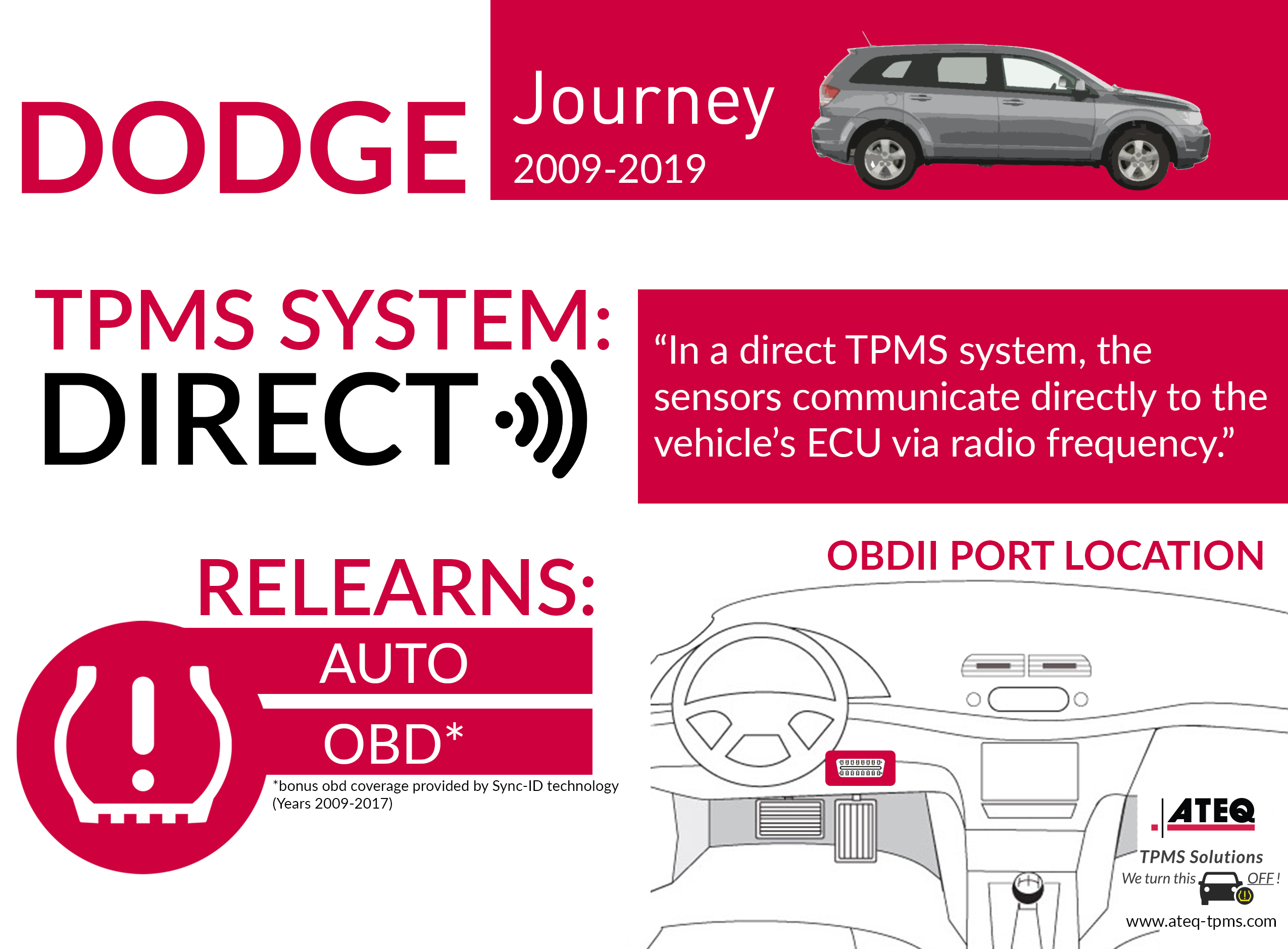
Type of TPMS system:
- Direct TPMS, TPMS sensors are installed in the wheel, tire pressure is communicated via radio frequency (RF) technology from the sensor to the vehicle’s ECU
OE and Aftermarket (Universal, Hybrid, Programmable, Configurable, One-to-One, OE-style) options for TPMS sensor replacement:
All OE, programmable, configurable, hybrid and OE-type (one-to-one) TPMS sensor options and service kits can be found in the VT56 , VT55 , VT36 TPMS Tools and most Powered by ATEQ tools.
Type of TPMS frequency:
Type of relearn procedures:.
- Auto relearn procedure
- Bonus OBD relearn procedure coverage as an option on the VT56 and VT46 branded tools for years 2009-2017, requires OBD module
Type of TPMS tool required for TPMS reset:
- TPMS activation tool such as VT15 , VT31 , VT36 or VT56 for auto relearn
- VT56 TPMS SCAN TOOL with OBDII module includes Sync ID technology for software versions DA1-25-04 and higher for bonus OBD relearn, available for years 2009-2017
Auto relearn procedure:
- Confirm TPMS sensors are properly installed
- Adjust tire pressure to placard value
- Hold TPMS tester on left front tire sidewall next to the valve stem, use TPMS tool to activate the sensor
- Repeat for the right front, right rear and left rear sensors
- Drive vehicle for up to 20 minutes above 15 mph or until TPMS light is off
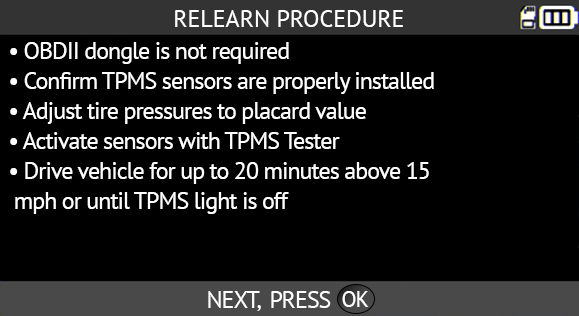
Bonus coverage, OBD relearn procedure, years 2009-2017:
- OBDII module is required, attach to the tool
- Hold TPMS tester on left front tire sidewall next to valve stem, use TPMS tool to activate the sensor
- Apply OBD module to DLC
- Turn ignition to ON
- Press OK on TPMS tool to transfer data to ECU
- Disconnect OBD module from DLC
- Turn ignition OFF then start the engine
- Drive for at least 5 minutes at 28 mph
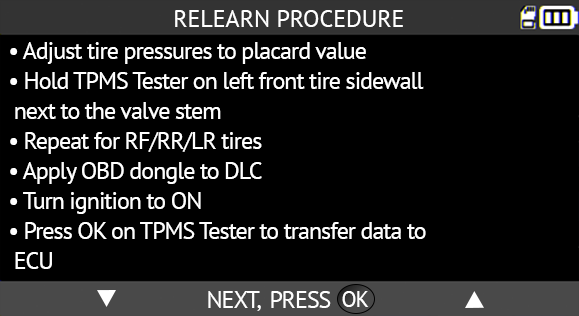
Troubleshooting tips
Oversized rims.
If you notice interference of your TPMS signal, it could be due to oversized rims which can cause RF signal interference.
Auto-relearn, the light won’t turn off?
The auto relearn procedure steps require the technician to drive for at least 5 minutes at 28 mph. Unfortunately, when you’re at the shop, it is not always easy or time-valuable to drive a vehicle around at over 28 mph for that amount of time. If the shop is in a city, it may not be possible to drive for over 28 mph unless the user drives outside of a city environment where it is possible to drive at higher speeds.
Solution? For RAM vehicles 2008-2017, the bonus OBD relearn procedure is available for the ATEQ VT56, thanks to patented Sync-ID technology. This advanced feature allows the user to perform an OBD relearn to turn the light off, with minimal to no driving time required to turn the light off, saving the technician time and the customer labor costs.
TPMS DTC code information
Use the VT56 to retrieve Dodge TPMS DTC codes by selecting the “Service” icon. After selecting the Make, Model, and Year, select the DTC code icon. Use the OBDII module to retrieve the Dodge DTC TPMS information to diagnose and service the TPMS issues determined.
Related News
TPMS diagnostic information – RAM 1500 2008-2020
Tpms diagnostic information on the top-selling vehicles of 2008 – toyota corolla, video: ateq vt56 tpms ford obd relearn protocols now available, subscribe to ateq tpms e-news.
Receive the latest software technical releases, tool information, trade shows and company news.
* Required fields
Let's Fix That Car
Car Owners Technical Reference
- Dodge TPMS Reset
TPMS Reset: Dodge Journey 2009-2019 Tire Pressure Sensor

Dodge Journey 2009-2019 Tire Pressure Monitoring System TPMS Reset
Easy to follow procedure on how to reset/relearn the TPMS service maintenance indicator warning light on Dodge Journey for the year 2009, 2010, 2011 and 2019.
Sensor Relearn Procedure without a Scan Tool:
1. Inflate all tires to pressure listed on the placard.
2. Turn the ignition to the ON position with the engine OFF (not the ACC position), and roll the driver’s side window down.
3. Let the vehicle sit, for 20 minutes, with the ignition ON. Turn the climate controls/NAV system OFF to limit battery drain.
4. During the 20 minutes, scan each sensor.
5. Drive the vehicle above 15 MPH for at least 20 minutes. All sensor IDs will be memorized automatically.
Sensor Relearn Procedure with a Scan Tool (If Available):
2. Select OBD II (PERFORM RELEARN on the ELITE Tool) from your Tool’s menu.
3. Starting with the LF tire, use your Tool to scan each sensor in the following order: LF, RF, RR and LR (and the full size spare if equipped).
4. After all sensor IDs have been read, turn the ignition to the ON position with the engine OFF (not the ACC position).
5. Connect the OBD II Connector to the Tool then to the vehicle’s OBD II port. Make sure your connection is secure and the green light is on.
6. Select UPLOAD CAR IDS, from the Tool’s menu, and upload the sensor IDs.
7. When RELEARN COMPLETE / IDs UPLOADED TO CAR is displayed, the IDs have been successfully uploaded.
8. With the ignition still in the ON position, re-scan each sensor.
9. Drive the vehicle above 15 MPH, for at least 20 minutes, and monitor the low tire pressure monitor to ensue it does not blink.
About Dodge Journey
Revisions for the 2011 model-year include modifications to the grille, lower front fascia, redesigned interior, suspension, steering, powertrain, and use of Dodge’s new logo, launched in 2011, as well as LED Taillights. Express and Mainstreet trim levels replace SE and SXT respectively, while Crew and Lux trims are also added to the lineup.
The 2011 Journey received new Uconnect 3 infotainment systems with either 4.3-inch (4.3″) or 8.4-inch (8.4″) LCD color touchscreen displays, and a full-color LCD Electronic Vehicle Information Center (EVIC) in the instrument cluster. The Keyless Enter-‘n’-Go System, with keyless access and push-button start, became standard on all Journey models.
For the 2012 model year, the Journey became Dodge’s smallest SUV after FCA stopped manufacturing the Nitro. SE and SXT trims return for 2012, replacing Express and Mainstreet trims, respectively. An American Value Package (AVP) model is also added for the United States market that is priced below the SE.
For the 2013 model year, Dodge released the Journey Blacktop, with 19-inch gloss black aluminum wheels and center caps, a gloss black grille, gloss black bezel headlamps, gloss black lower front fascia accent and gloss black exterior mirrors.
In 2014, the Journey Crossroad was introduced with chrome accents along the lower part of the body and in the interior, smoked head- and taillights, a black grille, rocker panels, rails for a roof rack, and a skid plate simile at the rear. Chrysler added the revised Dodge logo with two slanted rectangles for the 2013 Model Year. For the 2016 model-year, the Journey’s AVP and Limited trims were discontinued and the Crossroad Plus trim was added and also for the 2017 model-year, the R/T trim is replaced by the GT trim. (Source Wiki)
You may like to read:

TPMS Reset: Dodge Viper 2003-2016 Tire Pressure Sensor

TPMS Reset: Dodge Stratus 2007 Tire Pressure Sensor

TPMS Reset: Dodge Sprinter 2007-2013 Tire Pressure Sensor
Leave a reply cancel reply.
Your email address will not be published. Required fields are marked *
Save my name, email, and website in this browser for the next time I comment.
You may have missed

- Acura Transmission Oil Capacity
ACURA NSX Transmission Oil Capacity 1991-2020

ACURA RL Transmission Oil Capacity 1996-2012

ACURA Integra Transmission Oil Capacity 1996-2001

ACURA MDX Transmission Oil Capacity 2001-2020

ACURA CL and ILX Transmission Oil Capacity 2001-2020
Reset and Troubleshoot the Dodge Journey Tire Pressure Light (2008-2020)
What is the dodge journey tpms.
The low tire pressure alert on the Dodge Journey, though it might seem bothersome, plays a pivotal role in maintaining safety while driving. Comprising four key elements, the Dodge Journey’s tire pressure monitoring system (TPMS) seamlessly works to inform the driver of any tire air pressure issues: These include the Tire Pressure Sensors, the TPMS receiver module, the ECM, and the dashboard warning message for low air pressure.
How Does the Dodge Journey TPMS Work?
Sensors in Tires : Constantly measure air pressure and temperature of each tire.
Radio Wave Data Transfer : TPMS Sensors transmit real-time data to the Dodge Journey’s computer.
TPMS Receiver Module: Accepts and processes the tire pressure sensor data.
ECM’s Function: Compares tire pressure data with Dodge Grand Caravan set standards.
Air Pressure Drop Alert: Low tire pressure warning light is a yellow or orange exclamation mark.
TPMS Self-Assessment: The system self-checks and indicates any detected issues by flashing the low tire pressure alert symbol.
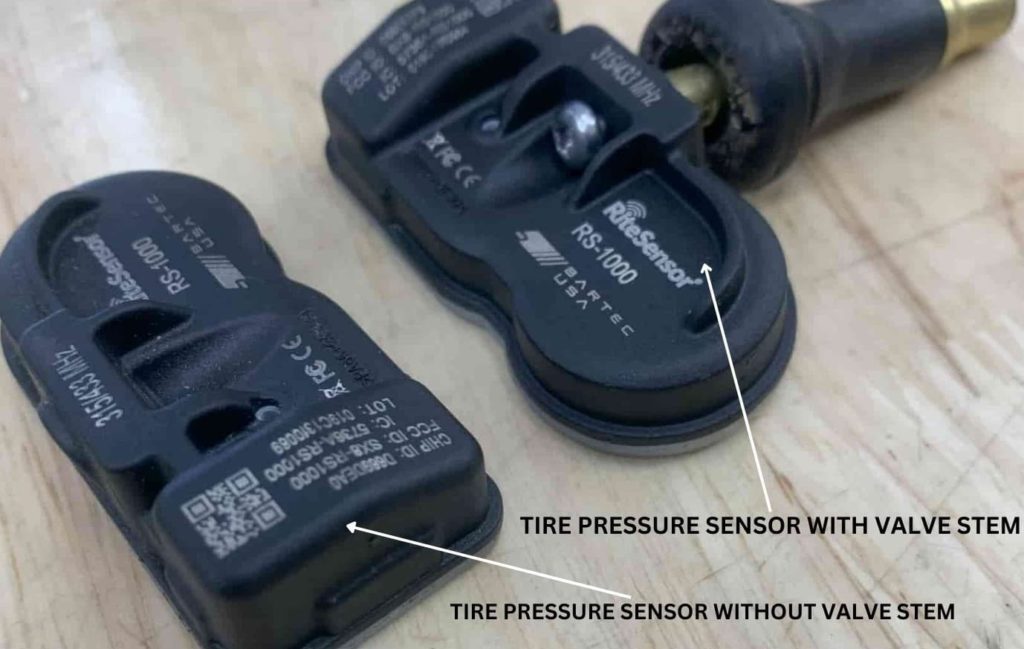
Steps to Reset the Dodge Journey Tire Light
Make sure the Dodge Journey tires have cooled, either by not driving or waiting for 3 hours after a drive.
Calibrate the air pressures in each tire to the exact recommended cold levels.
Drive the Dodge Journey for approximately 20 minutes, ensuring you go faster than 15 mph.
Note: The Dodge Journey Does Not Have a Tire Pressure Reset Button!
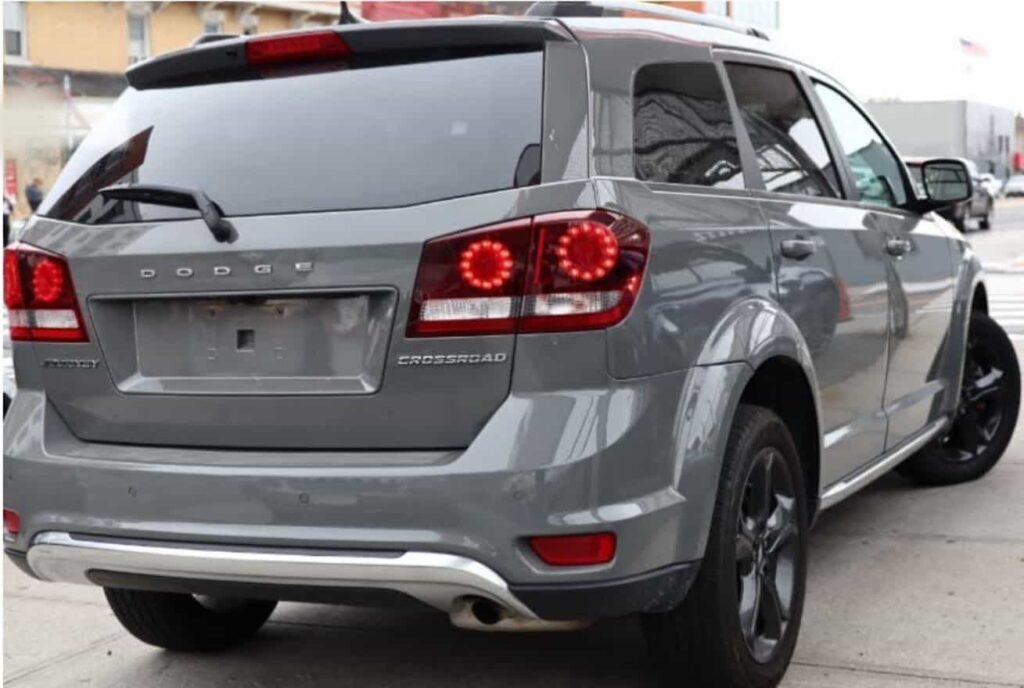
Steps to Deactivate the Dodge Journey Tire Pressure System
To turn off the Dodge Journey TPMS, ensure all four wheels are replaced with those lacking pressure sensors. After deactivation, tire pressure data will shift to dashes (~) on the display screen.
Mount 4 wheels devoid of TPMS sensors onto the Dodge Journey.
Drive your Dodge Journey for around 20 minutes, maintaining a speed greater than 15 mph (24 km/h).
Once done, the TPMS will emit a chime, with its warning indicator flashing for 75 seconds before remaining constant.
Turn the engine off and then back on.
On all following ignition starts, the TPMS alerts will be absent.
Once TPMS is off, expect tire pressure metrics to show as dashes (~) on your screen.
Steps to Reactivate the Dodge Journey Tire Pressure System
Reinstall the original wheels and tires with the tire pressure sensors in them onto the Dodge Journey.
Drive the Dodge Journey for approximately 20 minutes.
Cycle the engine on and off.
PORTABLE TIRE PUMP
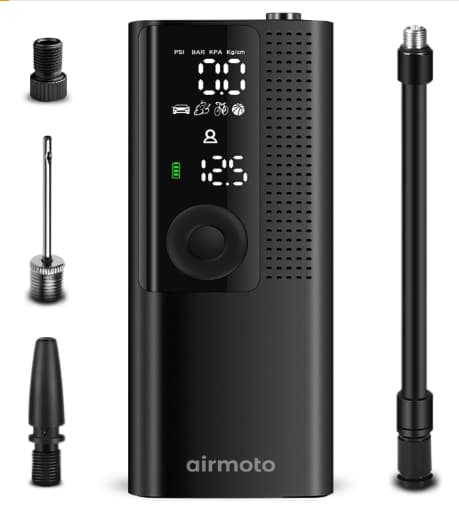
2020 Dodge Journey Tire Pressures
Why is your dodge journey's tire pressure light illuminated.
Tires with inappropriate air pressure (either too much or too little)
Tires exhibiting air leaks
Lacking pressure sensors in some tires
Inoperative or aged batteries in TPMS sensors
Technical hitches with the TPMS receiver module or Dodge Journey ECM
Interferences from surrounding electromagnetic sources from other cars or electronics
Pressure variations from weather or altitude transitions
Surpassing the vehicle’s recommended load weight
Use of chains on tires
Windows darkened excessively with tints
Temperature variations on roads
Bubbled , dry-rotted , or punctured tires
Off aligned wheels
TPMS governed by defective software
Drastic atmospheric temperature declines
Overlooking TPMS resetting after tire swaps or services
Flawed or damaged tire valves
Dodge Journey Tire Pressure Sensor Batteries
Each Dodge Journey tire features a pressure sensor containing a circuit board, antenna, and a non-replaceable battery. If that battery depletes, you’ll need to replace the entire sensor. Dodge Journey tire sensor batteries last 5 to 10 years or up to 150,000 miles.
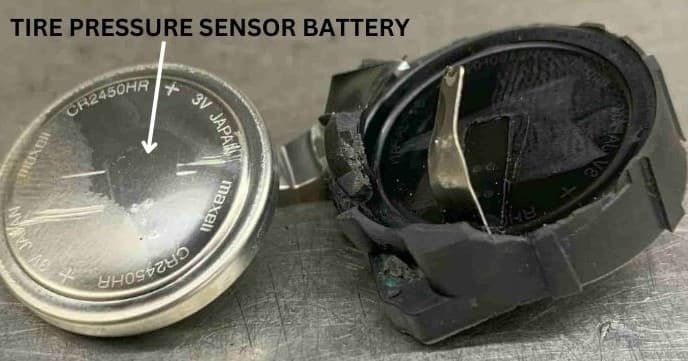
6 Tips to Troubleshoot the Dodge Journey Tire Light
Since the Dodge Journey comes without a tire pressure reset feature, addressing the low tire pressure light can involve some experimentation. Among the listed approaches, one should effectively diagnose the Dodge Journey’s tire pressure warning:
SOLUTION 1: IDENTIFY IF A TIRE IS EXPERIENCING AIR LOSS
If you notice one tire less inflated than the others, this typically indicates a leak. To confirm, do the following:
Give the tire a thorough visual assessment and ensure it’s inflated to the recommended cold pressure.
Drive the Dodge Journey, keeping a speed above 15 mph, until the TPMS alert disappears.
🎯 WHAT IT MEANS: If every sensor is in good order and the tires contain the right air quantity, the tire warning light should cease once the Dodge Journey is driven. But, if it disappears and re-emerges while driving, it’s a strong sign of a tire leak.
SOLUTION 2: REBOOTING YOUR DODGE JOURNEY'S ONBOARD COMPUTER
Every low tire pressure alert gets recorded in the Dodge Journey’s onboard computer. To potentially wipe these alerts and deactivate the warning light, you’ll need to reboot the Journey’s computer system. Proceed as follows:
Confirm that the Dodge Journey’s engine and all its power systems are shut off.
Detach the negative terminal from the Journey’s 12 Volt battery.
After waiting about a minute, re-link and fasten the negative terminal to the battery.
Drive for 30 minutes.
🎯 WHAT IT MEANS: Carrying out this routine should extinguish the tire alert. But, if the tire warning comes on again after your drive, it suggests a potential tire leak or an issue with one of the TPMS sensors.
AUTEL TPMS PROGRAMMING TOOL
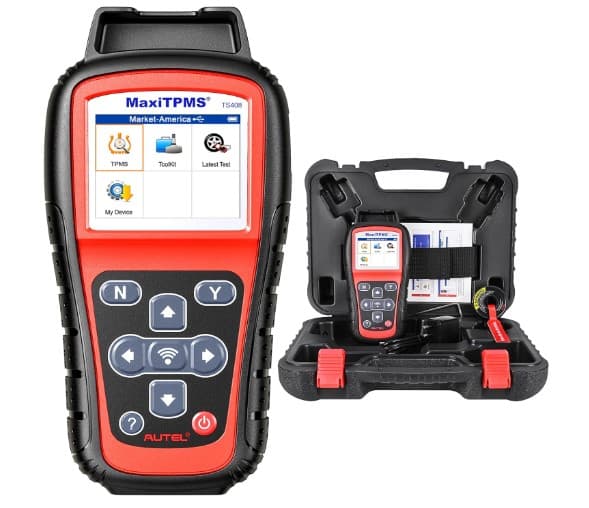
SOLUTION 3: EVALUATING AND TESTING TPMS SENSORS
For a thorough evaluation of each Dodge Journey TPMS sensor, you’ll need a TPMS programming tool or an OBD2 scan tool. The TPMS programming tool facilitates individual assessments of every tire’s pressure sensor. On the other hand, the OBD2 scan tool provides insights into any TPMS discrepancies and identifies tires with communication issues. To use a TPMS programming tool:
Link the tool to the Dodge Journey’s ECM by connecting it to the car’s OBD2 interface.
Comply with the directions provided by the tool and commence the inspection of each TPMS sensor, positioning the tool close to the valve stem on every tire and select the “test” or “trigger” function on the tool.
🎯WHAT IT MEANS : After testing of all tire pressure sensors, the TPMS programming tool will convey its analysis for each. If the tool faces challenges in accessing a sensor, indicates low or drained battery life, or shows irregular readings (like a tire temperature of -112 degrees), that Dodge Journey tire pressure sensor should be swapped out for a new one.
OBD2 TPMS SCAN TOOL
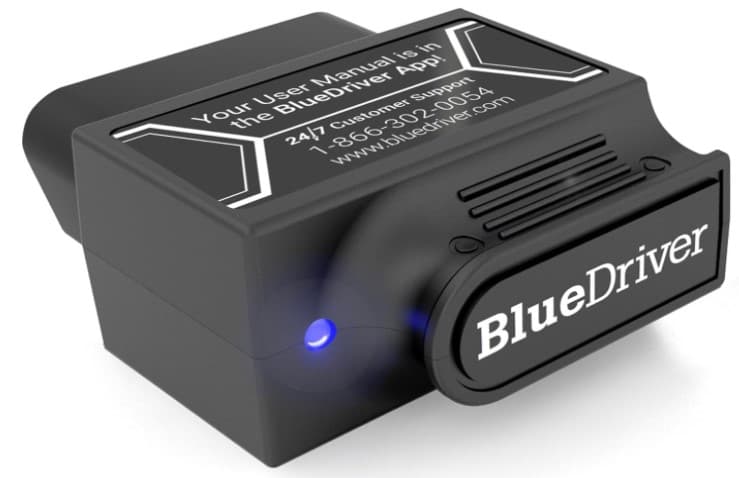
SOLUTION 4: STEP-BY-STEP GUIDE TO TRIGGER A DORMANT TIRE PRESSURE SENSOR
To rejuvenate a tire pressure sensor that’s not active (not due to low battery), execute these actions:
Lower the air pressure in the affected tire by roughly 15-20 Psi.
Fill that tire to 41-42 Psi (5 Psi above the suggested pressure).
Drive your Dodge Journey for approximately 15 minutes.
Once parked, bring the tire’s pressure down to the standard 36 Psi.
🎯WHAT IT MEANS : Should the usual Dodge Journey tire pressure reset process not be effective, give this method a shot.
SOLUTION 5: UNDERSTANDING TEMPERATURES HUGE IMPACT ON TIRE PRESSURE
The influence of temperature on tire pressure is profound. Both the ambient air temperature and the tire’s direct temperature can considerably alter its pressure. A 12-degree fluctuation in the air temperature can result in a change of about 1-2 Psi in tire pressure. For instance, a 70 to 30 degree temperature variation overnight could lead to a decrease in the Dodge Journey’s air pressure by at least 4 Psi, which can set off the low pressure alert. Driving dynamics also play a part; as tires warm up during a drive, their internal pressure increases. This underscores the importance of making tire pressure adjustments when they’re cold, prior to being driven. By grasping the interplay of these temperature factors, it’s evident how the Dodge Journey’s tire pressure alert might get triggered even without any leak.
🎯WHAT IT MEANS: Variations in tire pressure due to temperature changes are natural occurrences. The most effective way to counter this is by calibrating your Dodge Journey tire pressures when they’ve cooled down. Ideally, adjust them at the start of the day before any substantial driving, or after a very short drive. After parking, a span of roughly 3 hours is required for the tires to cool down to a “cold” status.
DIGITAL TIRE PRESSURE GAUGE
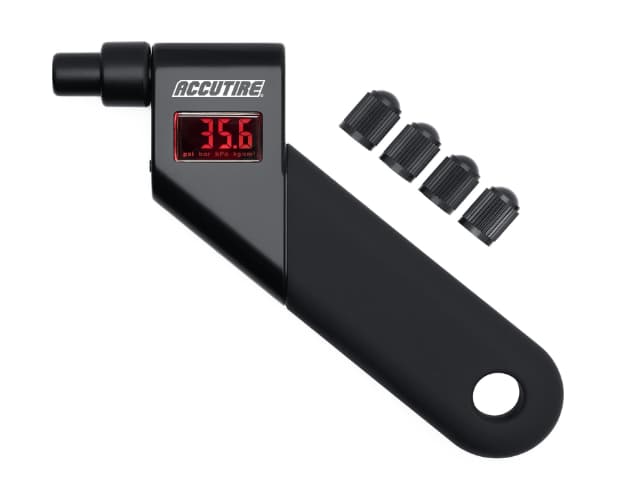
SOLUTION 6: A PRACTICAL APPROACH TO LOCATING TIRE LEAKS YOURSELF
Having assessed the prior 5 methods, and concluding that your tire does indeed have a leak, here’s how to pinpoint it: Required Tools : Detergent or soap, a spray container, water, and a tire air pump.
Mix water and soap in the spray container.
Pump up the tire suspected of leaking to at least 36 Psi.
Coat the tire comprehensively using the soap/water mixture.
Carefully scrutinize the Dodge Journey tire for any air bubbles forming.
🎯 WHAT IT MEANS : Trace the bubbles to their source, which is the exact location of the leak in the tire.
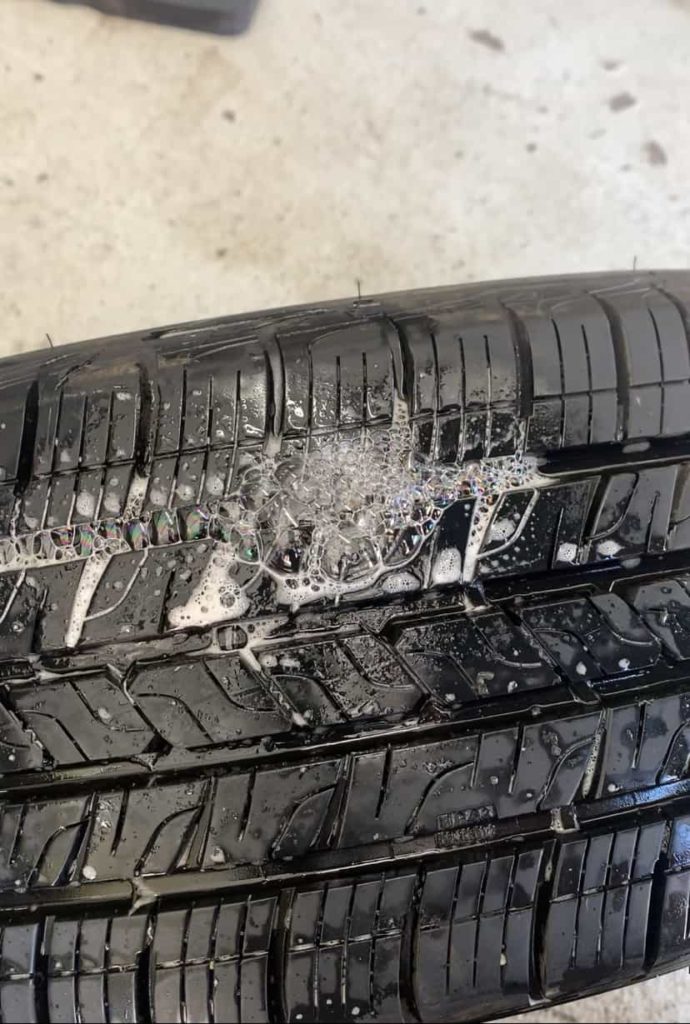
Common Dodge Journey Tire Pressure Questions
Tpms sensor guide for tire and wheel replacements.
When you switch the tires on your Dodge Journey, make sure to carry out the Dodge Journey TPMS reset steps. If you’re updating or changing the Dodge Journey wheels, you have the option to move the factory-installed tire pressure sensors to the replacement wheels or purchase and set up a new set of sensors tailored for the fresh wheels.
HOW CHANGING ALTITUDE IMPACTS YOUR DODGE JOURNEY'S TIRE PRESSURE
The tire pressure of a Dodge Journey isn’t just influenced by temperature; altitude plays a significant role too. As the vehicle climbs, with every increment of 1,000 feet, there’s a reduction in atmospheric pressure by roughly 0.5 psi. This leads to an effective air pressure increase in the tires. To illustrate, traveling from a beach to a height of 7,000 feet can cause the tires of your Dodge Journey to increase their pressure by an estimated 3.0 psi, even if the temperature remains constant.

IS DRIVING THE DODGE JOURNEY WITH THE TIRE LIGHT ILLUMINATED SAFE?
It’s unsafe to continue driving your Dodge Journey when the low tire pressure warning is on. If you notice the tire alert, find a safe spot to pull over and inspect the tires. Look over each tire visually and confirm the air pressure with a manual air pressure gauge . Driving with inadequate tire pressure compromises the safety of the driver, passengers, and also affects the car’s performance and safety features. The Dodge Journey’s tire pressure warning is activated due to either a low tire pressure reading or a faulty tire pressure sensor.
HOW FAR CAN I DRIVE THE DODGE JOURNEY WITH THE LOW TIRE PRESSURE LIGHT ON?
Continuing on the road without understanding the cause of the tire pressure light’s activation can increase the potential danger. There isn’t a defined limit, in terms of miles or time, for which it’s deemed okay to drive with the low tire pressure warning. The moment this alert appears, you should quickly check if it’s triggered by insufficient tire air or a defective tire pressure sensor. Driving the Dodge Journey with diminished tire pressure poses a significant risk. However, having a malfunctioning tire pressure sensor doesn’t inherently affect the car’s safety but does deprive you of precise tire pressure information on the information display.
WHAT DOES IT MEAN WHEN THE DODGE JOURNEY TIRE LIGHT IS FLASHING?
The Dodge Journey is equipped with a tire pressure monitoring system that includes a self-assessment capability. When there’s a communication breakdown between the monitoring system and a tire pressure sensor, this self-assessment function comes into play, also known as a TPMS malfunction . In such scenarios, the indicator for low tire pressure will blink momentarily for around a minute and then remain illuminated. For context, the Dodge Jorney’s spare tire isn’t fitted with a tire pressure sensor. Hence, when the spare tire is in use the TPMS is unable to interface with it due to its absence, leading to a TPMS malfunction. Likewise, a weakened or expired sensor battery can induce a TPMS malfunction.
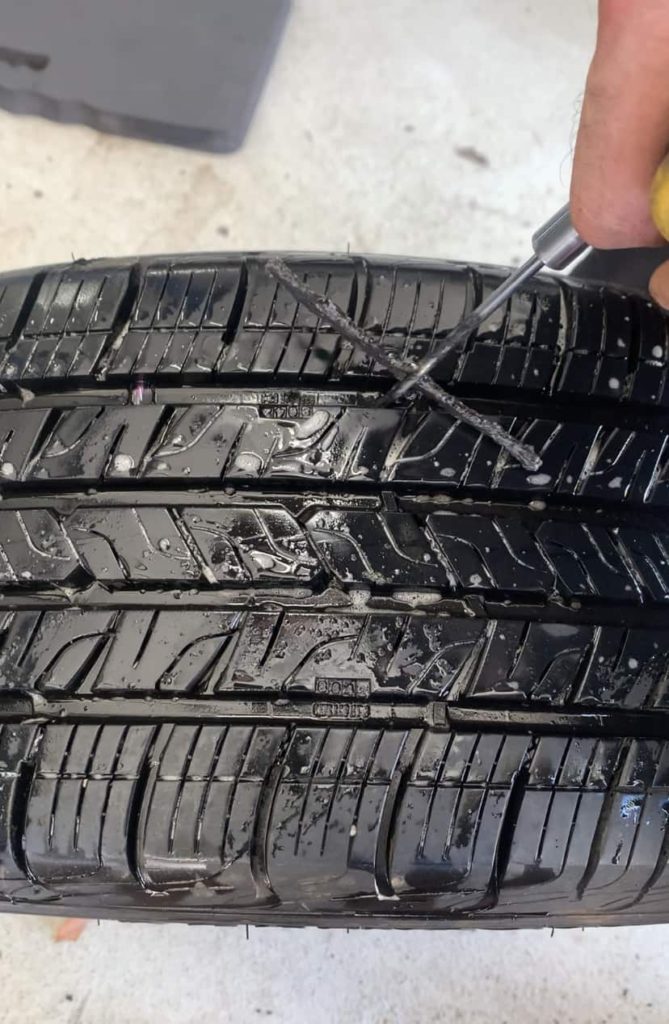
TIRE PLUG LIMITATIONS
Tire plugs are great for mending punctured tires, but it’s inadvisable to use them on tires with excessively worn-out treads or on the tire’s sidewall.
CAN TIRE SEALANTS COMPROMISE TIRE SENSOR INTEGRITY?
Applying tire sealants such as Slime or Fix-a-Flat to tires has the potential to negatively affect the electronics of a tire pressure sensor. Should you choose to use these products, ensure you get your car to an auto repair shop to have the sensor cleaned and its performance checked.
Everything in this article is applicable to all Dodge Journey models and versions made between 2008-2020.
Please note that this blog post contains Amazon affiliate links. This means that if you make a purchase through one of these links, we at TPMSRESET.COM may earn a small commission at no extra cost to you. We only recommend products that we personally use and believe in. Thank you for supporting us.

- Remember me Not recommended on shared computers
Forgot your password?
- Wheels & Tires
Tpms "service tire pressure system" code (pics included)
By alex519 July 2, 2021 in Wheels & Tires
- Reply to this topic
- Start new topic
Recommended Posts
Anyone know where to even start with this its showing I have pressure in my tires so thats working but yet I keep getting this on my dashboard I included a link to the photos
https://photos.app.goo.gl/7JGHZ1rbqBodknbe9
Link to comment
Share on other sites.
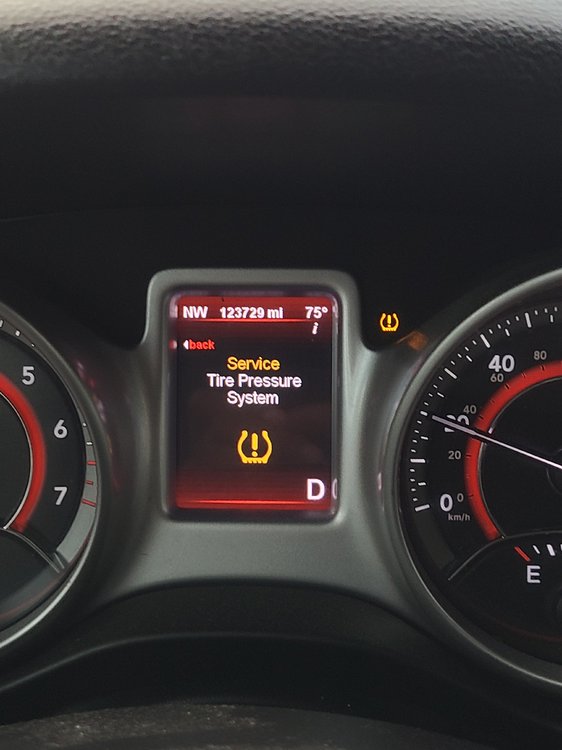
Here's the photos if the link don't work please help me so I don't waste money. Side note it shows tire psi all the way around
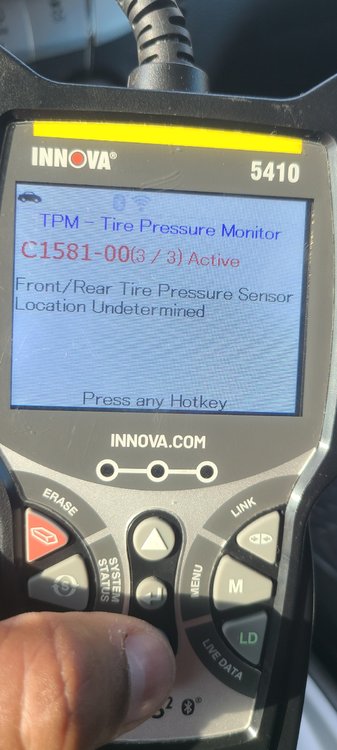
Move to the correct section. Sensor batteries are probably dead.

as jkeaton mentioned battery in the sensor is going bad,sense you dont mention air loss in the tires, any good tire shop should be able to help you, i use discount tire stores for all my work if you have one near you try them out they are great and wil be cheaper than most other places,,, stay away from pep boys
1 minute ago, 2late4u said: as jkeaton mentioned battery in the sensor is going bad,sense you dont mention air loss in the tires, any good tire shop should be able to help you, i use discount tire stores for all my work if you have one near you try them out they are great and wil be cheaper than most other places,,, stay away from pep boys
In all 4 it's reading I have pressure on the tires see
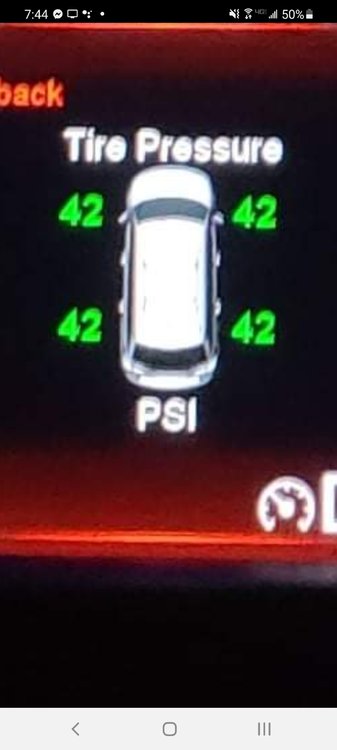
TPMS Life Expectancy
The estimated life expectancy of an OE TPMS sensor is 5 to 12 years, with the average lifespan being 7 years. TPMS life expectancy is directly related to the number of radio frequency transmissions the sensors make. Driving habits greatly influence the number of RF transmissions a sensor makes in its lifetime. For example: sensors usually transmit when the vehicle is stopped and transmit more often when in motion. Maintaining a constant speed, such as when you're on a highway, reduces the demand on TPMS sensors and allow the sensors to transmit less often. Drivers who often find themselves driving in start-and-stop type traffic will have a greater impact on the vehicles tire pressure monitoring sensors. Weather can also have an impact on tire pressure sensor battery life. Cold conditions allow batteries to last longer. Warmer conditions take more of a toll on TPMS battery life
2 minutes ago, alex519 said: In all 4 it's reading I have pressure on the tires see
since it is all of them, might be the receiver for the signals then, which will be a trip to the dealership or a garage that handles such repairs or a black section of electrical tape to cover up the warning so it doesn't bother you if you decided to go without fixing it,good luck and report back on what you find out is causing your problem
Actually, warnings can be set if pressure readings (as shown) go too high for TPMS software program. 42 psi seems a bit high, try lowering down some and see what happens.
Sensor battery problems tend to have that wheel position drop out showing press.
- Summer Solstice , 2late4u and jkeaton
2 hours ago, 5rebel9 said: Actually, warnings can be set if pressure readings (as shown) go too high for TPMS software program. 42 psi seems a bit high, try lowering down some and see what happens. Sensor battery problems tend to have that wheel position drop out showing press.
Lowered it some what is the ideal wheel psi for the 17in wheels?
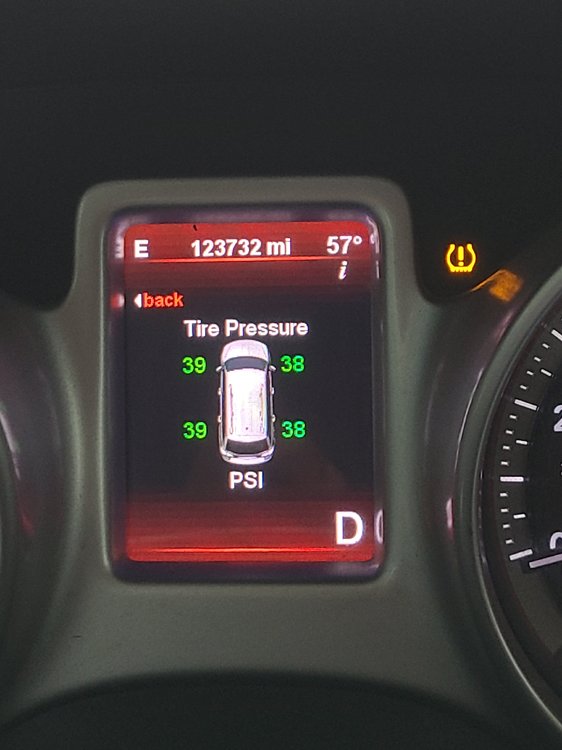
I set mine at 36 psi (COLD), but there is a sticker on the drivers door (or frame) that has the tire and pressure specs for you.
NOTE when changing pressures, to get accurate sensor readings you need to drive the car some for things to update and with warnings to be able to be self checked and cleared.
- Summer Solstice , 2late4u , OhareFred and 1 other
Further thoughts.....
You say you keep getting this message. Did you just rotate tires or get new ones put on? IF so then you still need to drive the carat least 1/2 mile at 30 mph for sensors/ receivers to learn/self check and CLEAR the warning message.
Further postings of concerns to a forum needs to have fullest info possible given for good suggestions to be made.
- 2late4u , jkeaton and larryl
- 2 weeks later...
From further experience( on saturday) I had a tire sensor replaced on our '11 DJ was there for the whole process of activating the sensor(an aftermarket brand) thru installation back on the car. Aftermarket scanner showed all good, but the EVIC message, pressure reading and warning light did NOT go away until I had driven 1.5 miles at speed. During this time, the warning light would give a single flash about every .3 miles. I believe this was from the system checking position and pressure of each tire as I stated earlier. The system of the car itself HAS to relearn by driving, and not just use of a scanner to reset lights or messages.
So on our DJ, we now have 2 new sensors on the front tires and originals on the rears since getting the car.
Summer Solstice

Your reset experience is normal for the Journey. I've had more than 1 flat tire to test that out.
1 hour ago, Summer Solstice said: Your reset experience is normal for the Journey. I've had more than 1 flat tire to test that out.
Had to replace a sensor on mine...it was shot
Join the conversation
You can post now and register later. If you have an account, sign in now to post with your account. Note: Your post will require moderator approval before it will be visible.

× Pasted as rich text. Paste as plain text instead
Only 75 emoji are allowed.
× Your link has been automatically embedded. Display as a link instead
× Your previous content has been restored. Clear editor
× You cannot paste images directly. Upload or insert images from URL.
- Insert image from URL
- Submit Reply
- Existing user? Sign In
More Forum Apps
- Online Users
- Leaderboard
|| Forum Activity ||
- All Activity
- Create New...

Dodge Journey Tire Pressure Light: Causes + How to Fix

The TPMS light indicates that your Dodge Journey’s tire pressure is above or below the minimum threshold set by the manufacturer.
The tire pressure monitoring system (TPMS) light is the most common warning light on a modern vehicle.

If you have a TPMS warning light, your vehicle’s tire pressure must be checked.
If your Dodge Journey has a tire pressure warning light, it can only be caused by a few things. Once you very that your vehicle has the proper tire pressure, the TPMS is not a safety concern or breakdown risk.
The most common reasons the TPMS light won’t go out are over or under-inflated tires or a tire pressure sensor-related issue.
How Tire Pressure Monitoring Systems Work
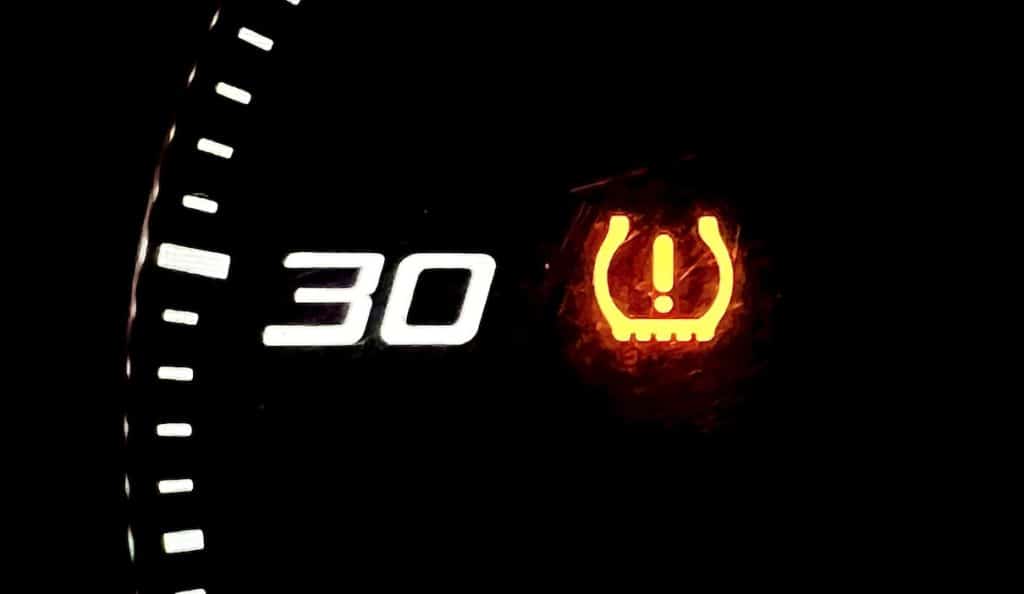
There are two main types of tire pressure monitoring technology. Your Dodge Journey almost certainly has the “direct” version.
Direct Monitoring
Direct tire pressure monitoring systems come on virtually all new vehicles.
- Tire Pressure Sensor s- They monitor the tire pressure in each wheel directly. They are battery-powered, transmit data wirelessly, and usually last about ten years.
- Receiver – The sensors are wireless and transmit data to a receiver; if the data from any of these sensors indicate that your Journey’s tire pressure is too low (usually 25% under the recommended pressure), the TPMS light will come on.
- TPMS Light – Indicates that one of the tire pressure sensors has detected an improperly inflated tire or there is an issue with the TPMS system.
Indirect (a very uncommon setup)
Indirect tire pressure monitoring takes data from the wheel speed sensors. It uses this data to report if the tire pressure is low. If a tire gets too low, it’ll turn minutely faster than a full tire. The wheel speed sensors pick up on this and report it to the PCM. It’s unlikely your Dodge Journey has this system.
Dodge Journey TPMS Light: How to Turn Off
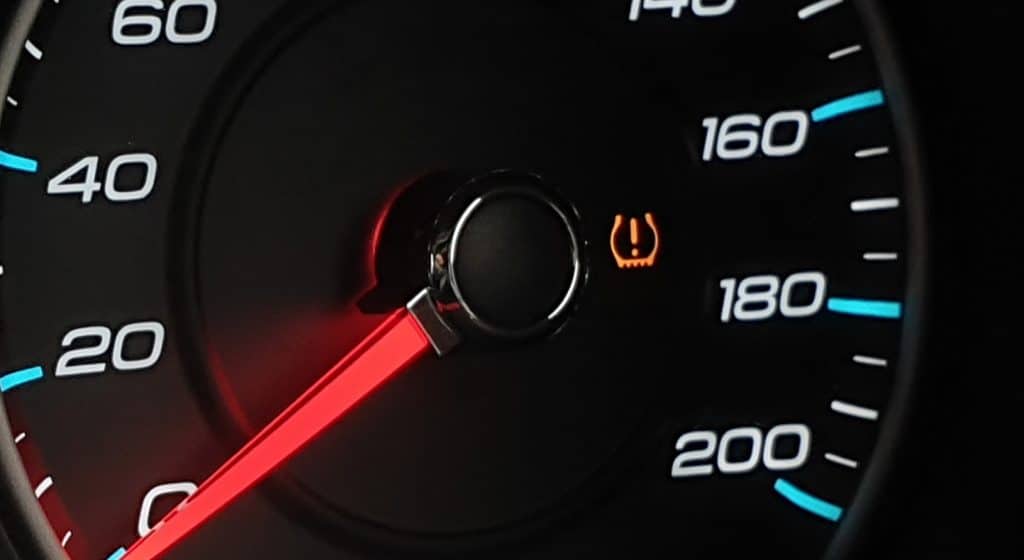
Check and fill all the tires. Once you know the tire pressure checks out, the TPMS light stops becoming a safety concern, even if it doesn’t turn off.
99% of the time, getting the tire pressure back to the recommended pressure will turn off your Journey’s TPMS light.
You should check all of your Journey’s tires simultaneously to avoid going through this process again in a few weeks (tires without leaks lose pressure at about the same rate).
Check the Tire Pressure
Check the tire pressure on all four of your vehicle’s wheels with a tire pressure gauge. Verify that they match the Dodge’s recommended psi (there’s a sticker that’ll tell you inside the driver’s door). Overinflated tires can be just as dangerous as underinflated tires.
Use the sticker on the inside of your Journey’s door. It has the manufacturer’s recommended tire PSI and size.
If the tires are underinflated, add air. If the tires are overinflated, let some air out. Most gas stations have an air compressor that you can use to add air. Some service stations will let you program the air pressure, while others only have an air hose.
If you need help filling a tire, there’s a section on inflating tires at the end of this article.
What if adding air didn’t help?
If your Journey’s TPMS warning light stays on after you’ve verified that the tire pressure is correct, jump down to the next section.
Dodge Journey: TPMS Light Staying On Causes
1. you haven’t driven since airing your tires.
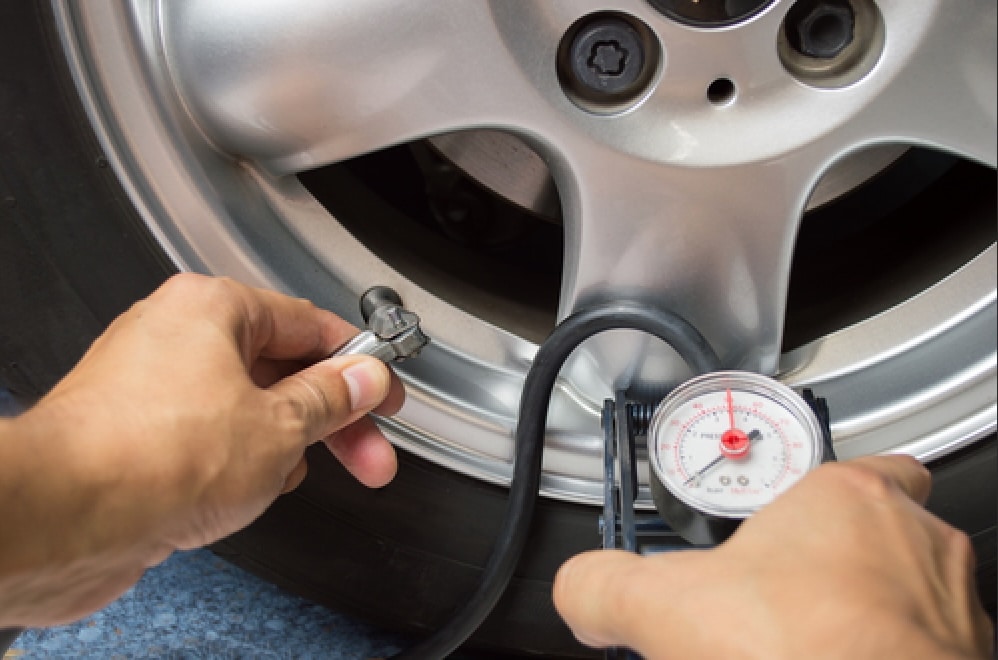
Your Dodge Journey’s tire monitoring systems want the vehicle to move a bit before verifying the tire pressure is back within spec.
If you are reading this and haven’t moved your vehicle around, try driving it and see if the tire TPMS light turns off.
2. Incorrect Tire Pressure

The tire pressure is below the required level: If one or more of your Journey’s tires has a pressure lower than recommended, your TPMS light will come on and stay lit until the pressure returns to the appropriate level.
If you’ve recently added pressure to your vehicle’s tires, it could be that you put TOO MUCH air in, which will keep the TPMS light on.
3. Faulty TPMS Sensor
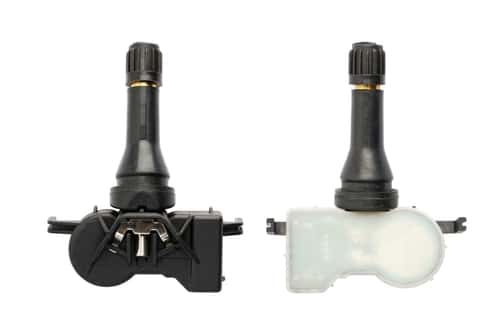
The TPMS is likely reporting that the tire pressure is still too low. A faulty TPMS sensor can cause your light to come on. The defective sensor may need to be replaced or reset.
Your Journey may have a “service tire pressure monitoring system” warning or a flashing TPMS light.
4. Low Battery in the TPMS Sensor
If the battery of your vehicle’s TPMS sensor is low, it can cause the light to come on. You may need to replace the battery for the light to turn off.
5. Damaged TPMS Valve Stem
The valve stem that transmits information from your tire to the TPMS receiver can become damaged or clogged, causing the light to come on. You may need to replace or clean this valve.
6. Issues After Rotating the Wheels
If you have recently rotated your Journey’s wheels, the TPMS system may need to reset.
Common Questions
Can you drive with the tpms light on.
If your tire pressure light is on even after manually checking your Journey’s tire pressure, it is entirely safe to drive with the TPMS light on. Just keep an eye on the tire pressure from time to time.
Driving with low tire pressure is not advisable. When your vehicle’s tire pressure is too low, it can cause damage to the sidewall, which can damage the integrity of the tire even after you inflate it.
Overinflation causes a tire to lose its ability to take impact from a bump. It also decreases the contact surface with the road and will show this by wearing more in the center (where it’s making contact with the road).
How do you check tire pressure?
Your Journey may give you tire pressure data. But, even if it does, it’s better to verify all four wheels with a tire pressure gauge manually.
- Unscrew the valve stem cap.
- Push the tire pressure gauge down onto the valve stem.
- Observe the tire pressure/
What should your vehicle’s tire pressure be?
A sticker inside your Journey’s driver door jamb should tell you the exact pressure for the front and rear wheels.
How long do TPMS sensors last?
The life expectancy of a TPMS sensor typically ranges from 5-10 years, depending on the type of sensor and the environment it is exposed to.
If one of the tire pressure sensors becomes damaged or its battery runs out of power before its expected lifespan, it can cause the TPMS light to come on in your vehicle’s dashboard.
Why is my TPMS light blinking?
The tire pressure light blinks to warn you that there is an issue with the tire pressure sensor (either defective or has a low battery) or the receiver is malfunctioning.
Most of the time, the TPMS will go off if you add air to your Dodge Journey’s tires. If it doesn’t go off, there is likely an issue with one of the wheel pressure sensors.
Dodge Journey: How To Reset The TPMS
If the Tire Pressure Management System in the Dodge Journey is not working properly, you may have to reset the system. Follow these steps to re-initialize the TPMS.
The light indicator is a notification to warn you of significantly low air pressure or high-pressure loss in your tires and is NOT to be ignored, as low pressure affects the vehicle’s overall performance, such as:
- How the vehicle drives
- Increases the need for fuel
- Tire failure
To Reset the Warning Light Perform the following steps :
Low Tire Pressure
New or repaired tire, new sensor or other malfunction, 2009 – 2023 models.
- When the Tire Pressure Monitoring System warning turns on, check which tire is low with a Pressure Gauge .
- Inflate the low tire until it is at the recommended PSI .
- Drive the vehicle for 20 minutes above 15 mph . The TPMS system will reset automatically.
- Place the new or repaired tire(s) on the vehicle.
- Make sure the tire is at the recommended PSI .
- Make sure all tires are at the recommended PSI .
- Drive the vehicle for 20 minutes above 15 mph . The TPMS system will reset automatically.
- The TPMS warning light on your Dodge Journey should be cleared.
What if the light doesn’t turn off?
If the light remains illuminated, it might be because the outdoor temperature affects how fast the air in the tires will adjust to the right temperature. This could take minutes or a day or two, so be patient and give the tires time to adjust. If the tire pressure warning light stays illuminated past a week, you will need to have your vehicle serviced. There could possibly be a sensor issue or a tire puncture.
NOTE : If you are unable to Reset the Tire Pressure Warning Light on the first try, REPEAT the steps. If you are still unsuccessful, contact the dealership for assistance or consult your vehicle user’s manual.
Related posts:
1 thought on “dodge journey: how to reset the tpms”.
Need actual picture of location of the toms reset button on 2015 dodge journey
Leave a Comment Cancel reply

Home » Troubleshooting » Dodge Journey low tire pressure warning light causes, how to reset
Dodge Journey low tire pressure warning light causes, how to reset
Dodge Journey is equipped with Tire Pressure Monitoring System (TPMS) for the purpose of warning the driver when one or more of the tires are significantly under-inflated, creating a potentially unsafe driving condition. In this article we discuss the reasons for the amber colored TPMS warning light in Journey, and how you can reset it.
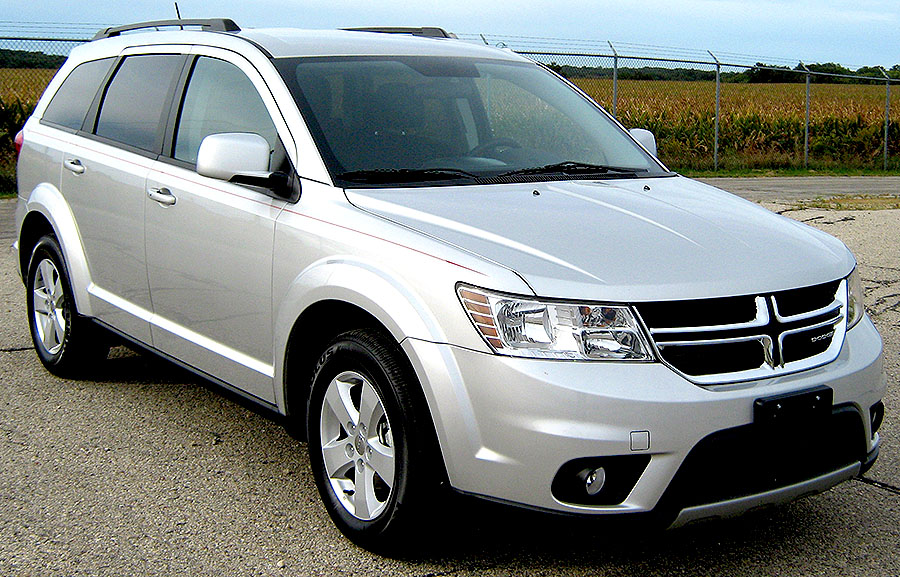
The TPMS warning light illuminates in Dodge Journey when air pressure is low in one or more of the tires, battery has depleted in a pressure sensor, TPMS receiver module has malfunctioned, or a pressure sensor has been damaged.
Low tire pressure

Reinflate the tires
Reinflate all the tires of your Journey to the manufacturer specified air pressure, which is mentioned on the vehicle placard or tire inflation pressure label usually located on the B-pillar or the edge of the driver door. If you can’t find the label, check the size of your tire which is mentioned on the sidewall of the tire, and match it to the tire pressure information shown below.
- 225/55R19 99H: 36 psi
- 225/65R17 102H: 36 psi
- P225/65R17 100H: 36 psi

Resetting the TPMS warning light
After you have inflated all the tires to the correct air pressure, the TPMS warning light will turn off automatically when the vehicle is driven for up to 20 minutes above 15 mph (24 km/h). Dodge Journey uses the direct method for monitoring tire pressure, which means a pressure sensor actively records the internal pressure and air temperature of the tire on each wheel. There is no need to reinitialize the TPMS system in order to reset the warning light. There is no reset button like the one you see in vehicles with indirect TPMS system which uses ABS sensors to detect low tire pressure. If the low tire pressure light does not turn off automatically after reinflating the tires in your Journey, increase the tire pressure by 5 psi on top of the factory recommended value, and drive your vehicle for at least 10 miles (16 km). After the TPMS warning light turns off, and the vehicle has been parked for a few hours, reduce the tire pressure to the factory recommended value.
Chilly weather can turn on low tire pressure light in Journey
Cold weather is one of the most common cause for low tire pressure warning light in Dodge Journey. When analyzing WheelsJoint’s statistical data, it has been observed that there is sharp rise in the number of searches for TPMS warning light causes at the start of every winter season, about three times higher as compared to mid summer season.

The air, like most other substances, expands when heated and contracts when cooled. So when the weather gets colder, the tire pressure decreases, which could trigger TPMS warning light in Journey. The tire pressure will vary with temperature by about 1 psi (7 kPa) for every 12°F (6.5°C).

Inflate tires when cold
Tire pressure in Journey should always be set based on cold inflation tire pressure. This is defined as the tire pressure after the vehicle has not been driven for at least three hours, or driven less than 1 mile (1.6 km) after a three-hour period.
Do not adjust tire pressure when hot
The tires on your Journey can get around 50 degrees hotter than the outside temperature when you’re driving, which increases the tire pressure by about 4 psi – this is normal and there should be no adjustment for this increased pressure.
Does altitude affect tire pressure?
Yes, altitude can change tire pressure values, but it is negligible and not a cause for concern. If you drive your Journey from sea level to Mount Evans Scenic Byway in Colorado which is the highest paved road in North America at the altitude of 14,130 feet (4,307 m), the tire pressure should theoretically increase by approximately 6 psi. But, the decrease in ambient temperature at higher elevation contracts the air in tires and compensates for any altitude pressure changes.
Is it safe to drive Journey with low tire pressure?
The driving characteristics of Journey change even if the air pressure is 5 psi less than manufacturer’s recommended value: the braking distance can be longer, cornering worse, and at particularly high speeds there is even a risk that the tire will burst. Low tire pressure also increases tire wear, and the higher rolling resistance of the tire means higher fuel consumption. So it is recommended to reinflate the tires to the correct pressure as soon as possible.
Dead battery in a tire pressure sensor
Each tire pressure sensor in Journey is powered by a built-in lithium-ion battery. When the battery is depleted, the sensor stops transmitting tire pressure information to the receiver module. When this happens, the TPMS warning light will flash every time the engine is started, and will remain illuminated until you turn off the vehicle.

How long do the pressure sensor batteries last?
The tire pressure sensor batteries usually last anywhere from 5 to 10 years in Journey. When the battery is depleted, you must replace the sensor itself, as the battery is sealed into the sensor unit and is non-replaceable.
Identifying a faulty pressure sensor
The most reliable method for detecting a faulty tire pressure sensor or a sensor with dead battery is by testing each sensor with a scan tool. For example, MaxiTPMS TS408 is commonly used for diagnosing and programming tire pressure sensors. A sensor that is not detectable by the scanner is most likely defective and should be replaced with a new one.

If you don’t want to spend over a hundred bucks on a scanner, then head over to any reputable tire shop and perform a TPMS diagnostic scan of your Journey. Some shops like Discount Tire and Pep Boys offer free of charge TPMS diagnostic services.
Installed new tires?
If a pressure sensor stopped responding after you installed new tires on your Journey, it is possible the sensor got damaged during tire installation. These sensors are quite sensitive, and can be easily damaged if utmost care is not taken while changing tires.
Dodge Journey TPMS user guide
The Tire Pressure Monitoring System (TPMS) will warn the driver of a low tire pressure based on the vehicle recommended cold placard pressure.
The TPMS will warn the driver of a low tire pressure if the tire pressure falls below the low-pressure warning limit for any reason, including low temperature effects and natural pressure loss through the tire.
The TPMS will continue to warn the driver of low tire pressure as long as the condition exists, and will not turn off until the tire pressure is at or above the recommended cold placard pressure. Once the low tire pressure warning (TPMS Warning Light) illuminates, you must increase the tire pressure to the recommended cold placard pressure in order for the TPMS Warning Light to turn off.
The system will automatically update and the TPMS Warning Light will turn off once the system receives the updated tire pressures. The vehicle may need to be driven for up to 20 minutes above 15 mph (24 km/h) in order for the TPMS to receive this information.
When filling warm tires, the tire pressure may need to be increased up to an additional 4 psi (28 kPa) above the recommended cold placard pressure in order to turn the TPMS Warning Light off.
For example, your vehicle may have a recommended cold (parked for more than three hours) placard pressure of 30 psi (207 kPa). If the ambient temperature is 68°F (20°C) and the measured tire pressure is 27 psi (186 kPa), a temperature drop to 20°F (-7°C) will decrease the tire pressure to approximately 23 psi (158 kPa). This tire pressure is sufficiently low enough to turn on the TPMS Warning Light. Driving the vehicle may cause the tire pressure to rise to approximately 27 psi (186 kPa), but the TPMS Warning Light will still be on. In this situation, the TPMS Warning Light will turn off only after the tires are inflated to the vehicle’s recommended cold placard pressure value.
Tire Pressure Monitoring System Low Pressure Warnings
The Tire Pressure Monitoring System (TPMS) Warning Light will illuminate in the instrument cluster and a chime will sound when tire pressure is low in one or more of the four active road tires. In addition, the instrument cluster will display an “Inflate to XX” message and a graphic showing the pressure values of each tire with the low tire pressure values shown in a different color.
Should this occur, you should stop as soon as possible and inflate the tires with a low pressure condition (those shown in a different color in the instrument cluster graphic) to the vehicle’s recommended cold placard pressure inflation value as shown in the “Inflate to XX” message. Once the system receives the updated tire pressures, the system will automatically update, the graphic display in the instrument cluster will change color back to the original color, and the TPMS Warning Light will turn off. The vehicle may need to be driven for up to 20 minutes above 15 mph (24 km/h) in order for the TPMS to receive this information.

Service Tire Pressure System Warning
If a system fault is detected, the Tire Pressure Monitoring System (TPMS) Warning Light will flash on and off for 75 seconds and then remain on solid. The system fault will also sound a chime. In addition, the instrument cluster will display a “Service Tire Pressure System” message for a minimum of five seconds and then display dashes (- -) in place of the pressure value to indicate which sensor is not being received.
If the ignition switch is cycled, this sequence will repeat, providing the system fault still exists. If the system fault no longer exists, the TPMS Warning Light will no longer flash, and the “Service Tire Pressure System” message will no longer display, and a pressure value will display in place of the dashes. A system fault can occur due to any of the following:
- Signal interference due to electronic devices or driving next to facilities emitting the same radio frequencies as the TPMS sensors.
- Accumulation of snow or ice around the wheels or wheel housings.
- Using tire chains on the vehicle.
- Using wheels/tires not equipped with TPMS sensors.
Vehicles With Compact Spare
- The compact spare tire or non-matching full size does not have a Tire Pressure Monitoring System sensor. Therefore, the TPMS will not monitor the pressure in the compact or non-matching full size spare tire.
- If you install the compact or non-matching full size spare tire in place of a road tire that has a pressure below the low-pressure warning limit, upon the next ignition key cycle, the TPMS Warning Light will remain on and a chime will sound. In addition, the graphic in the instrument cluster will still display a different color pressure value and an “Inflate to XX” message.
- After driving the vehicle for up to 20 minutes above 15 mph (24 km/h), the TPMS Warning Light will flash on and off for 75 seconds and then remain on solid. In addition, the instrument cluster will display a “Service Tire Pressure System” message for five seconds and then display dashes (- -) in place of the pressure value.
- For each subsequent ignition key cycle, a chime will sound, the TPMS Warning Light will flash on and off for 75 seconds and then remain on solid, and the instrument cluster will display a “Service Tire Pressure System” message for five seconds and then display dashes (- -) in place of the pressure value.
- Once you repair or replace the original road tire and reinstall it on the vehicle in place of the compact spare or non-matching full size, the TPMS will update automatically. In addition, the TPMS Warning Light will turn off and the graphic in the instrument cluster will display a new pressure value instead of dashes (- -), as long as no tire pressure is below the low-pressure warning limit in any of the four active road tires. The vehicle may need to be driven for up to 20 minutes above 15 mph (24 km/h) in order for the TPMS to receive this information.
Premium System
The Tire Pressure Monitoring System (TPMS) uses wireless technology with wheel rim mounted electronic sensors to monitor tire pressure levels. Sensors, mounted to each wheel as part of the valve stem, transmit tire pressure readings to the receiver module.
- The TPMS has been optimized for the original equipment tires and wheels. TPMS pressures and warning have been established for the tire size equipped on your vehicle. Undesirable system operation or sensor damage may result when using replacement equipment that is not of the same size, type, and/or style. The TPMS sensor is not designed for use on aftermarket wheels and may contribute to a poor overall system performance or sensor damage. Customers are encouraged to use OEM wheels to ensure proper TPMS feature operation.
- Using aftermarket tire sealants may cause the Tire Pressure Monitoring System (TPMS) sensor to become inoperable. After using an aftermarket tire sealant it is recommended that you take your vehicle to your authorized dealer to have your sensor function checked.
- After inspecting or adjusting the tire pressure always reinstall the valve stem cap. This will prevent moisture and dirt from entering the valve stem, which could damage the TPMS sensor.
- The TPMS is not intended to replace normal tire care and maintenance or to provide warning of a tire failure or condition.
- The TPMS should not be used as a tire pressure gauge while adjusting your tire pressure.
- Driving on a significantly underinflated tire causes the tire to overheat and can lead to tire failure. Underinflation also reduces fuel efficiency and tire tread life, and may affect the vehicle’s handling and stopping ability.
- The TPMS is not a substitute for proper tire maintenance, and it is the driver’s responsibility to maintain correct tire pressure using an accurate tire pressure gauge, even if underinflation has not reached the level to trigger illumination of the TPMS Warning Light.
- Seasonal temperature changes will affect tire pressure, and the TPMS will monitor the actual tire pressure in the tire.
TPMS Deactivation — If Equipped
The Tire Pressure Monitoring System (TPMS) can be deactivated if replacing all four wheel and tire assemblies (road tires) with wheel and tire assemblies that do not have TPMS sensors, such as when installing winter wheel and tire assemblies on your vehicle.
To deactivate the TPMS, first replace all four wheel and tire assemblies (road tires) with tires not equipped with Tire Pressure Monitoring System (TPMS) sensors. Then, drive the vehicle for 20 minutes above 15 mph (24 km/h). The TPMS will chime, the TPMS Warning Light will flash on and off for 75 seconds and then remain on. The instrument cluster will display the “Service Tire Pressure System” message and then display dashes (–) in place of the pressure values.
Beginning with the next ignition cycle, the TPMS will no longer chime or display the “Service Tire Pressure System” message in the instrument cluster but dashes (–) will remain in place of the pressure values.
To reactivate the TPMS, replace all four wheel and tire assemblies (road tires) with tires equipped with TPMS sensors. Then, drive the vehicle for up to 20 minutes above 15 mph (24 km/h). The TPMS will chime, the TPMS Warning Light will flash on and off for 75 seconds and then turn off. The instrument cluster will display the “Service Tire Pressure System” message and then display pressure values in place of the dashes. On the next ignition cycle the “Service Tire Pressure System” message will no longer be displayed as long as no system fault exists.
Reset the entire system
If the low tire pressure warning light won’t turn off due to a glitch in the tire pressure monitoring system, it may be possible to reset the TPMS system by resetting all on-board computers in your Journey. This method should only be considered as a last resort, when all else fails.

You can reboot all the on-board computers by disconnecting the main 12 volt battery for a few minutes. Remove the cable from the negative terminal of the battery first, then from the positive terminal. With the battery disconnected, press the horn button a few times and turn on the headlights to drain out all the residual electricity from the system. After about 15 minutes, reconnect the battery in reverse order: positive cable first, then negative cable.
Tire pressure keeps getting low
If the TPMS warning light turns on frequently in your Journey, and the tire pressure is also decreasing after you have reinflated the tires, there may be an air leak. One or more of the tires may have been punctured by an external object, or the air may be leaking from a defective value stem.

Use OBD2 scanner for diagnosis
Since Dodge Journey is equipped with on-board diagnostics (OBD), a fault diagnosis can provide initial indications of where the malfunction is located. But when it comes to TPMS, a basic code reader will not suffice. You will need an advanced scanner to monitor TPMS data or read TPMS codes.

BlueDriver is a commonly used scanner by DIYers that can read TPMS codes for most vehicles and isn’t too expensive – costs about a hundred bucks. You can also clear the TPMS fault codes with this device which will turn off the warning light, but the light may come back on if the on-board diagnostic system detects a fault again.

- Dodge Neon AC not cooling – causes and diagnosis
- Mini Clubman bad mass air flow sensor (MAF) symptoms and causes
- Ford Mustang key fob not working – causes and how to fix it
- Toyota 4Runner slow acceleration causes and how to fix it
- Audi A1 bad O2 sensor symptoms, causes, and diagnosis
- Is VW Touareg key fob waterproof?
- Toyota FJ Cruiser AC not cooling – causes and diagnosis
- A revolutionary battery for Mercedes-Benz eCitaro
- Kia Seltos AC blower motor not working – causes and diagnosis
- BMW 1 Series dirty cabin air filter symptoms, when to replace
- Nissan Rogue steering wheel vibration causes and diagnosis
- Ferrari Monza SP2 uneven tire wear causes
- Toyota Prado bad spark plugs symptoms, causes, and diagnosis
- How to use Sport, Eco and Eco+ drive modes on Hyundai Kona Electric
- Ram 4500 Heavy Duty steering wheel controls not working – causes and how to fix it
- Pontiac Grand Prix horn not working – causes and how to fix it
- Mitsubishi Delica AC not cooling – causes and diagnosis
- Kia Niro won’t start – causes and how to fix it
- VW Atlas low AC refrigerant symptoms, how to recharge
- Hyundai Ioniq horn not working – causes and how to fix it
What Does “Service Tire Monitor System” Mean?
- Updated: February 12, 2023
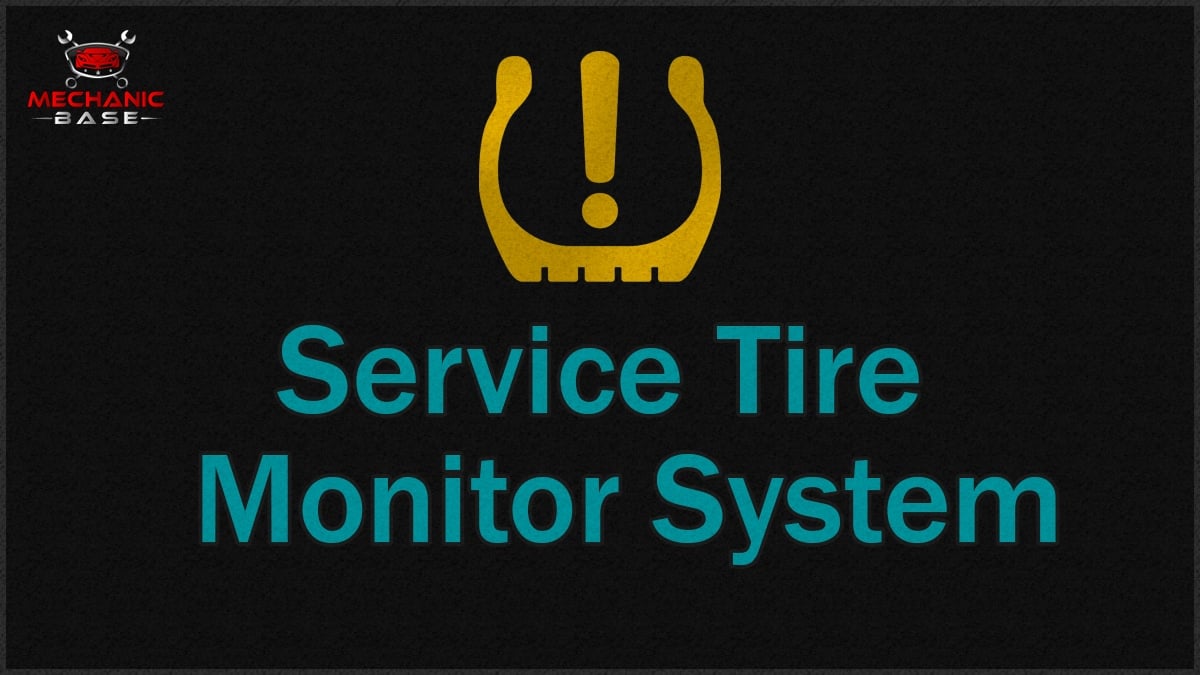
It doesn’t matter how old a car is, there’s always the chance of seeing a warning light or message on the dashboard or infotainment system. One such message that happens on vehicles of all ages is the Service Tire Monitor System alert. What does this warning mean, what caused it and how can you fix it?
In this guide, we answer all of those questions surrounding your tire monitoring system. You will learn what the system is for and what causes a malfunction.
Additionally, there are step-by-step instructions showing what to do when the message comes on. Furthermore, we also give you some additional answers to questions you’ve been pondering.
What Does Service Tire Monitor System Mean?
The Service Tire Monitor System message indicates something is wrong with the tire pressure monitoring equipment. It’s usually a separate warning from the normal TPMS message. When this message alerts you, you will likely also see the low tire pressure light on the dashboard and the warning message on the infotainment system.
If there’s just a malfunction due to low tire pressure , you may not see this message. For the most part, when the issue is tire pressure related, the alert on new cars will include information about which tire is low, so you can fill it up.
Instead, this warning is trying to show you that the equipment for the TPMS isn’t working. You will often find the Service Tire Monitor System message in GM, Buick, and Chevy vehicles.
What Is A Tire Monitor System?
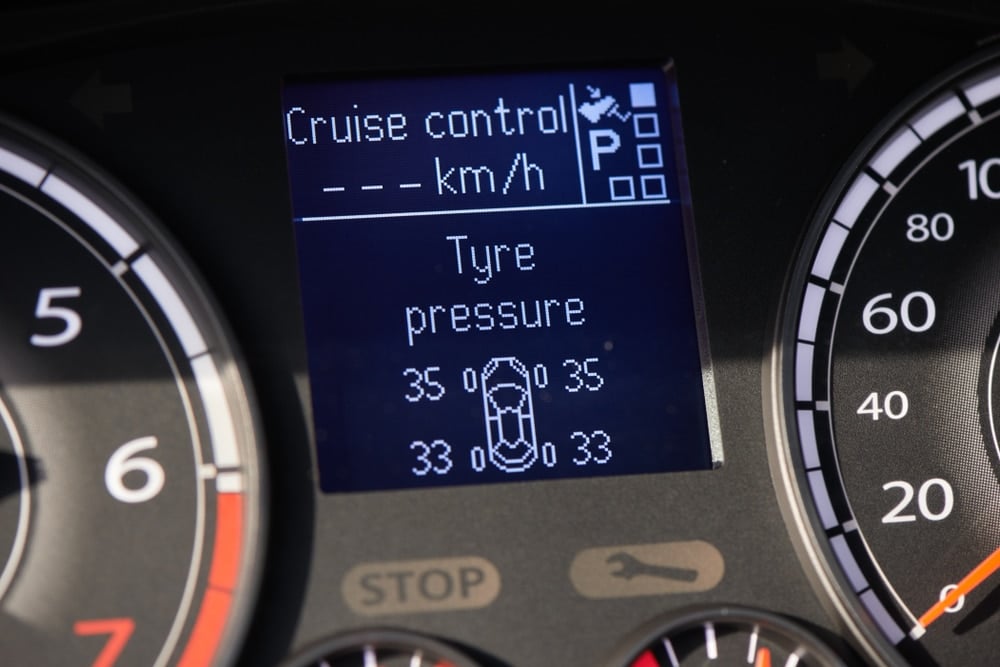
The Tire Monitor System is the TPMS equipment. With this feature, the air pressure in all of the tires is being measured to ensure safety. When a tire gets too low, the alert goes off so you can fill it up with air.
With most of the newer models, the TPMS light would come on and the infotainment system would tell you which tire is low. Because of the alert, drivers no longer have to rely on manually checking tire pressures regularly.
The system is also advanced enough to tell you when something is wrong with the sensors or calibration. In these cases, the TPMS light might come on, but so will a warning telling you to service the tire monitor system.
Causes Of Service Tire Monitor System Message
The Service Tire Monitor System message is usually caused by a faulty component within the TPMS system, such as a bad TPMS sensor, low battery, or faulty calibration or programming. However, it could potentially also be caused by low tire pressure.
Here are a few things that could cause the Service Tire Monitor System message:
1. Tire Pressure Sensor Lost Memory
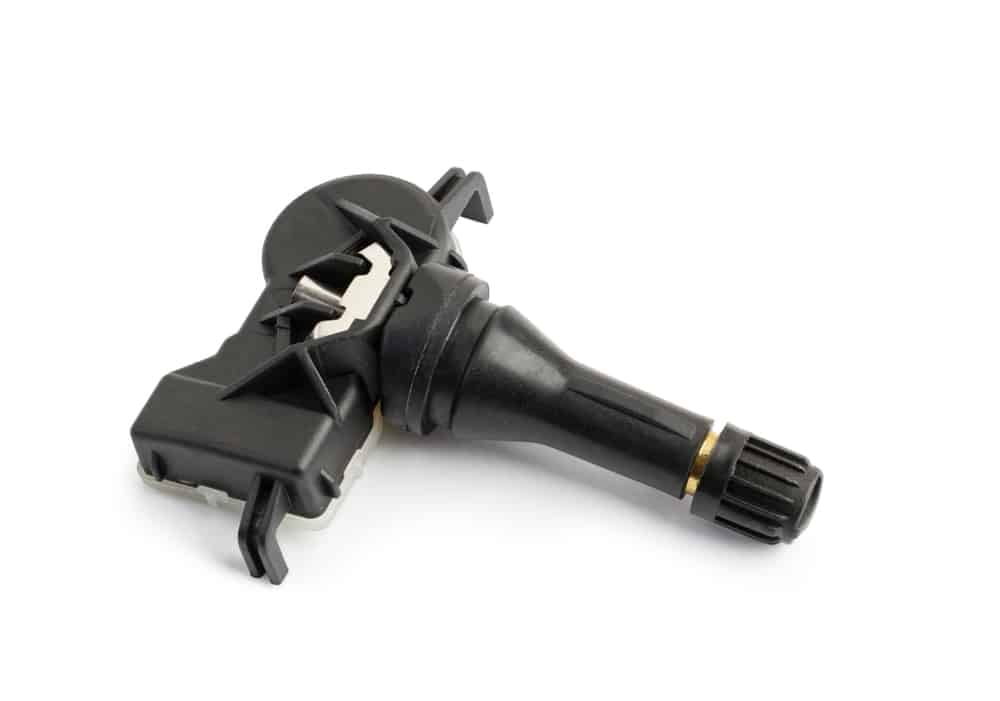
On the tire pressure monitors, there’s a lithium-ion battery that keeps it powered up. These batteries tend to last for around five years under normal use. They can fail prematurely if they have been exposed to extreme weather or conditions.
If the battery dies, the sensor stops communicating with the PCM . Because there’s no data being relayed, the service message pops up until you put in a new battery.
2. Faulty Tire Pressure Sensor
On every tire, there’s a TPMS sensor with a radio signal attached. This tire sensor monitors air pressure and lets you know if it gets low. These sensors are subject to a lot of wear simply because of how close to the road they are.
If the sensor gets contaminated with debris, dirt or too much water, it can fail. Sensors can also fail because of too much sealant around the stem valves. Additionally, corrosion has been known to take some out.
With the sensor out of commission, the PCM can’t read the tire pressure. Therefore, an alert is sent out to tell you there’s a problem.
READ MORE: 3 Symptoms Of A Bad Tire Pressure Sensor (& Replacement Cost)
3. Changed Wheels Without Reset

If you swap out the wheels on your car, the new sensors must be calibrated. This service requires a special TPMS tool , making it difficult for many people to do at home without a workaround method.
Without this calibration, you will get the Service Tire Monitor System message. During a reset, the sensors relearn the processes and connect with the computer.
4. Tire Pressure Sensor Not Reset
The sensors need to be recalibrated any time they are changed. This doesn’t just occur when you change out the wheels but also when a sensor must be replaced.
If you swapped out the sensor but didn’t do the reset, the message is going to appear. You can use a TPMS tool to recalibrate it or several workaround tactics.
5. Low Tire Pressure
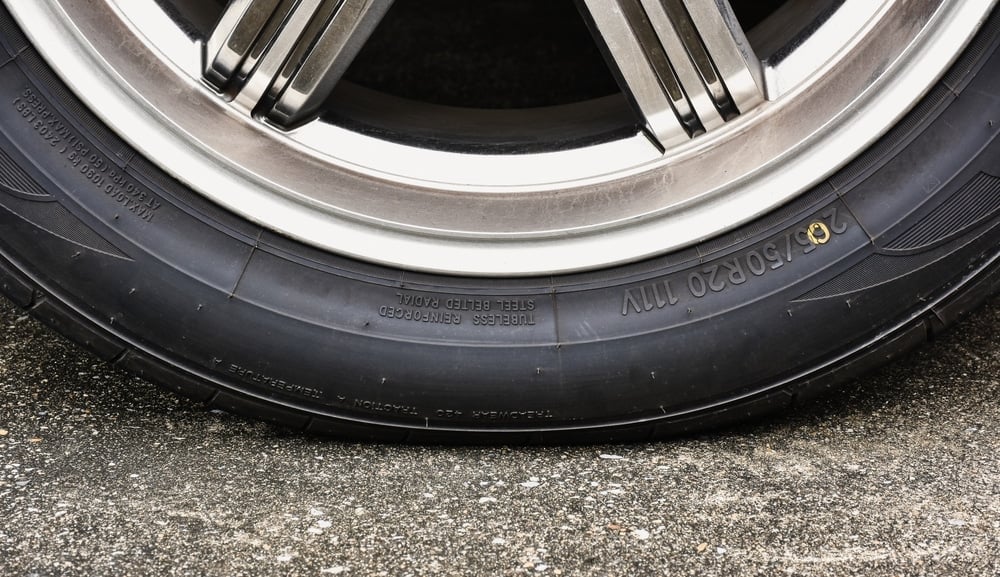
When tire pressures get low, it’s common to see the TPMS light on the dashboard. In many cases, the system will also tell you which tire is low, so you can resolve the problem.
While it’s rare to see the Service Tire Monitor System with a low tire, it’s not impossible. There could be a malfunction causing the service message to alert you instead of just the low tire information. Your tire pressures should be checked regularly anyway, so now seems like a good time.
6. Bad Car Battery
All of the electronics are running through the power supplied by the car battery. If there’s a problem with the car battery, these high-tech sensors can fail to read. The PCM will think that something has happened with the sensor and send out an alert.
The good news is that when the battery is to blame, there are normally other signs of a problem. After all, the battery dying normally causes issues with everything from starting the car to running the lights.
How To Fix The Service Tire Monitor System Message
To fix the Service Tire Monitor System message, you need to diagnose what’s causing this warning light with an OBD2 scanner. You also want to ensure that the tire pressure is correct and reset the TPMS system.
In some cases, you will be able to repair the Service Tire Monitor System message in your home garage without any special tools. We outline a few possible solutions that can help you out.
1. Correct The Tire Pressure
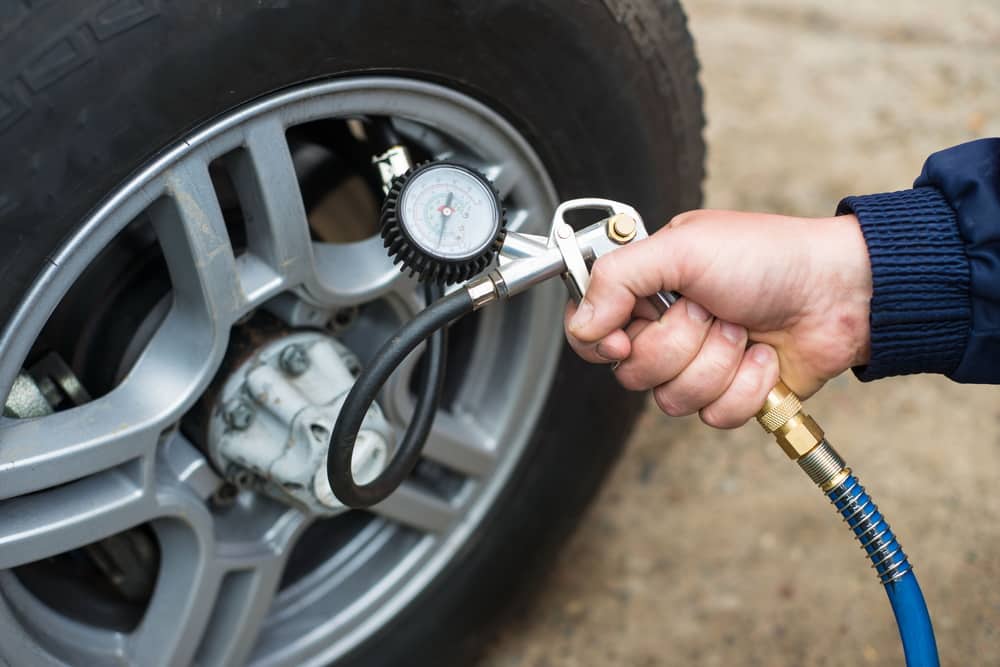
Just in case the warning is on because of low tire pressures, you should start here. You can verify the tire pressures with your home gauge. Match up the pressure you see with the data on the driver’s side door jamb.
If you verified that the tire pressures are normal and the light remains on, you know this isn’t the problem. You will want to move on to the next steps.
2. Reset Tire Pressure Light

If you believe that the sensors just need to be reset, you have multiple options. A reset is necessary any time that the sensors are replaced, new tires are installed or service has been performed. Look in the service manual to see the appropriate procedure for your vehicle.
You can have the reset done with a TPMS tool. There are also some cars with a button for resetting or you may be able to drive for a short time until it resets.
READ MORE: How to Reset Tire Pressure Light (TPMS) – By Car Model
3. Read Trouble Codes
You can try to read trouble codes with your OBD-II scanner . Not all scanners are going to read these codes, but you should have success if your diagnostic tool is advanced.
You may have other lights on the dashboard as well that the code scanner will help you understand. With the free trouble code listing at MechanicBase, you can figure out what’s wrong with ease.
4. Reprogram Tire Pressure Sensors
After the sensors are replaced, a reprogramming is required. The sensors need to learn the parameters used by the PCM.
With a TPMS tool, you can recalibrate the sensors. If you don’t have this tool, most tire shops will handle the reprogram in a matter of minutes.
5. Replace The Car Battery
If the issue seems to be related to power, you may be having trouble with the battery. Run a voltage check on the battery to see if it’s charged. If you don’t know how to do this, you can take the battery to most auto part stores for a free check. Once the battery starts to fail, it’s best to replace it.
Additionally, corrosion on the battery terminals can disrupt the power supply. If you see corrosion, use a baking soda and water mixture to clean it off. Reconnect the battery and see if it works better.
6. Contact A Professional
There aren’t too many more issues that could be occurring with the Service Tire Monitor System message. Most likely, you’ve figured out the problem by now. If you haven’t, there could be a deeper fault with the electrical system.
Some issues can be troublesome to diagnose and repair. If it feels like the issue is over your head, go ahead and visit your local auto repair shop instead. After all, you don’t want to continue driving with this message on the dashboard.
How Do You Fix A Service Tire Monitor System Message?
You can fill up the car tires if they are low. Aside from that, you may need to replace a sensor or have it reset. The sensor may also need to be recalibrated. In rare occurrences, the car battery could be causing the issue, requiring a replacement. After a complete diagnosis, you should know how to proceed.
Can You Drive With A Service Tire Monitor System Message?
If the tire pressures are normal, there’s nothing stopping you from driving with the message on. However, you may not know when a tire does have low pressure with this message already lit. You could be driving with pressures that are at dangerous levels. For that reason, it’s best to have it fixed right away.
How Much Does It Cost To Fix A Service Tire Monitor System Message?
If you need to fill up a tire, you can use your air compressor and do the job for free. Resetting and reprogramming the sensors doesn’t cost a lot either. Most tire shops will also replace a sensor for between $40 and $75. The highest cost fix might be to get a new battery, costing around $100 to $450, depending on what type of car you drive.
How Long Does A Tire Pressure Monitoring System Last?
The batteries on the tire pressure monitoring sensors tend to last around five years. Aside from the batteries, the sensors can also fail at times. Because of where the sensors are located, it’s possible for dirt and grime to build up and cause trouble.
The Service Tire Monitor System comes on the dash and infotainment system when the TPMS malfunctions. It could be caused by low tire pressure, a malfunctioning sensor, a needed reset or recalibration, plus a dying car battery. Start by checking tire pressures to see what’s going on.
Beyond that, you must perform your own diagnosis to see what might have failed. Most fixes are simple enough to perform at home, so there’s not a lot of cost involved. While this problem might not be as critical as some of the other messages that come on the dashboard, it should never be ignored.
Learn more:
- Tire Pressure Sensor Fault (What It Means & How to Fix It)
- Tire Pressure Light Blinking: Meaning, Causes & How To Fix It
- Low Tire Pressure Light Is On But Tires Are Fine – Causes & Fix
Categories: Tires , Warning Lights
Related Posts

Latest Posts
- The Best & Worst Years Of Ford Explorer
- Best & Worst Years Of Toyota Corolla
- Best & Worst Years of Toyota RAV4
- When Should Your Child Switch To A Forward-Facing Car Seat?
- The Best & Worst Years Of Toyota Camry
- I Accidentally Put Premium Gas In My Car, What To Do?

Dodge Journey: TIRE PRESSURE MONITOR SYSTEM (TPMS)
The tire pressure will vary with temperature by about 1 psi (6.9 kPa) for every 12°F (6.5°C). This means that when the outside temperature decreases, the tire pressure will decrease. Tire pressure should always be set based on cold inflation tire pressure. This is defined as the tire pressure after the vehicle has not been driven for at least three hours, or driven less than 1 mile (1.6 km) after a three hour period. The cold tire inflation pressure must not exceed the maximum inflation pressure molded into the tire sidewall. Refer to “Tires – General Information” in “Starting and Operating” for information on how to properly inflate the vehicle’s tires. The tire pressure will also increase as the vehicle is driven. This is normal and there should be no adjustment for this increased pressure.
For example, your vehicle may have a recommended cold (parked for more than three hours) placard pressure of 33 psi (227 kPa). If the ambient temperature is 68°F (20°C) and the measured tire pressure is 28 psi (193 kPa), a temperature drop to 20°F (-7°C) will decrease the tire pressure to approximately 24 psi (165 kPa). This tire pressure is low enough to turn ON the Tire Pressure Monitoring Telltale light. Driving the vehicle may cause the tire pressure to rise to approximately 28 psi (193 kPa), but the Tire Pressure Monitoring Telltale light will still be on. In this situation, the Tire Pressure Monitoring Telltale light will turn off only after the tires are inflated to the vehicle’s recommended cold placard pressure value.
• The TPMS is not a substitute for proper tire maintenance, and it is the driver’s responsibility to maintain correct tire pressure using an accurate tire pressure gauge, even if under-inflation has not reached the level to trigger illumination of the Tire Pressure Monitoring Telltale light.
• Seasonal temperature changes will affect tire pressure, and the TPMS will monitor the actual tire pressure in the tire.
• Tire Pressure Monitoring Telltale light.
5. Using wheels/tires not equipped with TPMS sensors.
5. Once you repair or replace the original road tire and reinstall it on the vehicle in place of the compact spare, the TPMS will update automatically and the TPMS Telltale light will turn off, as long as no tire pressure is below the low-pressure warning limit in any of the four active road tires. The vehicle may need to be driven for up to 20 minutes above 15 mph (25 km/h) in order for the TPMS to receive this information.
The TPMS consists of the following components: • Receiver module . • Four Tire Pressure Monitoring Sensors . • Three Trigger modules (mounted in three of the four wheel-wells) . • Various Tire Pressure Monitoring System messages, which display in the Electronic Vehicle Information Center (EVIC) . • Tire Pressure Monitoring Telltale light .
Should this occur, you should stop as soon as possible and inflate the tires with low pressure (those flashing in the EVIC graphic) to the vehicle’s recommended cold placard pressure value. Once the system receives the updated tire pressures, the system will automatically update, the graphic display in the EVIC will stop flashing, and the Tire Pressure Monitoring Telltale light will turn off. The vehicle may need to be driven for up to 20 minutes above 15 mph (25 km/h) in order for the TPMS to receive this information.
When a system fault is detected, the Tire Pressure Monitoring Telltale light will flash on and off for 75 seconds and then remain on solid. The system fault will also sound a chime. In addition, the EVIC will display a CHECK TPM SYSTEM message for three seconds and then display dashes (- -) in place of the pressure value to indicate which sensor is not being received.
5. Once you repair or replace the original road tire and reinstall it on the vehicle in place of the compact spare, the TPMS will update automatically. In addition, the TPMS Telltale light will turn off and the graphic in the EVIC will display a new pressure value instead of dashes (- -), as long as no tire pressure is below the low-pressure warning limit in any of the four active road tires. The vehicle may need to be driven for up to 20 minutes above 15 mph (25 km/h) in order for the TPMS to receive this information.
• This device must accept any interference received, including interference that may cause undesired operation.
TIRE ROTATION RECOMMENDATIONS
Fuel requirements.
DRIVING ON SLIPPERY SURFACES Acceleration Rapid acceleration on snow covered, wet, or other slippery surfaces may cause the front wheels to pull erratically to the right or left. This phenomenon occurs when there is a differe ...
Bottle, coolant recovery Description NON-PRESSURE Fig. 52: NON-PRESSURE COOLANT RECOVERY CONTAINER - COOLANT RECOVERY CONTAINER - OVERFLOW HOSE - RADIATOR PRESSURE CAP The coolant recovery system used on 2.4L e ...
Fluid, differential Standard Procedure STANDARD PROCEDURE - DIFFERENTIAL ASSEMBLY FLUID CHANGE Fig. 79: Differential Assembly Fluid Change The drain plug (2) for the differential assembly is located in the bottom of ...
Dodge Journey Owners Manual
- Things to know before starting your vehicle
- Understanding the features of your vehicle
- Understanding your instrument panel
- Starting and operating
- What to do in emergencies
- Maintaining your vehicle
- Maintenance schedules
- If you need consumer assistance
Dodge Journey Service Manual
- Accessories and Equipment
- Differential and Driveline
- Heating & Air Conditioning
- Front Suspension
- Transmission

How to Properly Maintain and Service Tire Pressure System on your Dodge Journey
by topratedseoexperthridoy | Feb 13, 2024 | Tyre Care | 0 comments
If you need to service the tire pressure system in a dodge journey, it’s best to take the vehicle to a certified mechanic. The mechanic will be able to diagnose any issues with the tire pressure monitoring system and make necessary repairs.
The tire pressure system in a dodge journey is a vital component for ensuring safe and efficient driving. By maintaining proper tire pressure, you can improve fuel efficiency and extend the life of your tires. Drivers should be attentive to any warning lights indicating tire pressure issues and address them promptly to ensure optimal vehicle performance.
Regular maintenance and checks on the tire pressure system will contribute to a smooth and safe driving experience.

1. SEINECA 56029527AA 433MHz Tire Pressure Monitoring System (TPMS) Sensor Compatible with Dodge Charger Journey Grand Caravan Magnum Routan Chrysler 300 Sebring Town & Country
- Brand : SEINECA
- Manufacturer : SEINECA
- Color : 1pc
Enhance your driving safety with the SEINECA 56029527AA 433MHz TPMS Sensor. Compatible with various Dodge and Chrysler models, this sensor ensures accurate tire pressure monitoring. Its 433MHz frequency provides reliable transmission for real-time data. The easy-to-install design makes it convenient for vehicle owners. With this TPMS sensor, you can maintain optimal tire pressure and improve fuel efficiency. Drive with peace of mind and keep your vehicle’s tires in top condition with this reliable sensor.
- Advantages and Benefits:
- Enhances Safety: The SEINECA 56029527AA TPMS Sensor ensures optimal tire pressure, reducing the risk of blowouts and accidents.
- Cost Savings: By monitoring tire pressure, this sensor prolongs tire lifespan, helping you save on replacement expenses.
- Easy Installation: With its compatibility with various Dodge and Chrysler models, installing the SEINECA 56029527AA TPMS Sensor is hassle-free.
- Real-time Monitoring: This sensor provides accurate and timely tire pressure readings, allowing you to address issues promptly.
- Improved Fuel Efficiency: Maintaining proper tire pressure helps optimize fuel consumption, resulting in better mileage and cost savings.
Our Recommendations
I recently installed the SEINECA 56029527AA TPMS Sensor on my Dodge Charger. It’s compatible with various Dodge and Chrysler models. The installation process was quick and hassle-free. The sensor provides accurate tire pressure readings. I feel more confident on the road knowing my tire pressures are constantly monitored. I highly recommend this product to anyone looking for a reliable TPMS sensor.
Check Latest Price

2. 4 Pack Tire Pressure Monitoring System TPMS Sensors For Jeep Grand Cherokee Wrangler Dodge Charger Challenger Journey Ram 1500 Chrysler 300 Town Country 2011 2012 2013 2014 2015 2016 56029398AB 433MHz
- Brand : YAOPEI
- Manufacturer : Di Pei
Upgrade your Jeep, Dodge, or Chrysler with this 4-pack of TPMS sensors. Designed for various models from 2011 to 2016, these sensors provide accurate tire pressure monitoring. With a frequency of 433MHz, they ensure reliable communication between your vehicle and the sensors. Easy to install, these sensors will help you maintain optimal tire pressure for improved safety and fuel efficiency. Don’t compromise on quality and choose these TPMS sensors for a worry-free driving experience.
- Enhance safety: The TPMS sensors monitor tire pressure and provide real-time alerts, ensuring safer driving conditions.
- Extend tire lifespan: By maintaining optimal tire pressure, these sensors prevent premature wear and tear, resulting in longer-lasting tires.
- Save fuel: Properly inflated tires improve fuel efficiency, reducing the overall cost of driving.
- Easy installation: These sensors are designed for specific Jeep, Dodge, Chrysler, and Ram models, making installation quick and hassle-free.
- Reliable performance: With a frequency of 433MHz, these TPMS sensors offer accurate and consistent tire pressure readings for improved peace of mind while on the road
I recently purchased the 4 Pack Tire Pressure Monitoring System TPMS Sensors for my Jeep Grand Cherokee and I am extremely impressed. The sensors are compatible with various Jeep, Dodge, and Chrysler models from 2011 to 2016. They operate at a frequency of 433MHz, ensuring accurate and reliable tire pressure readings. The installation process was straightforward, and the sensors have been working flawlessly since. I highly recommend these TPMS sensors for anyone in need of a reliable and affordable solution for monitoring their tire pressure.

3. SEINECA 5Pack 56029398AB 433MHz Tire Pressure Monitoring System (TPMS) Sensor Compatible with Jeep Grand Cherokee Wrangler Dodge Charger Challenger Journey Chrysler Fiat Ram 1500 2500 3500 4500 5500
- Color : set of 5
Enhance your driving experience with the SEINECA 5Pack 56029398AB 433MHz TPMS Sensor. Monitor tire pressure effectively and ensure safety on the road. Compatible with a wide range of vehicles including Jeep, Dodge, Chrysler, Fiat, and Ram. Easy to install, providing hassle-free convenience for vehicle owners. Keep your tires in optimal condition and enjoy a smooth, worry-free ride. The SEINECA TPMS sensor is a reliable and practical addition to your vehicle.
- Enhance Safety: The SEINECA TPMS Sensor provides real-time monitoring of tire pressure, ensuring optimal safety on the road.
- Improved Fuel Efficiency: By constantly monitoring tire pressure, this sensor helps to maintain the perfect tire inflation, which can lead to better fuel efficiency.
- Easy Installation: The 5Pack TPMS Sensor is compatible with various Jeep, Dodge, Chrysler, Fiat, and Ram models, making it hassle-free to install and use.
- Cost-Effective Solution: By preventing premature tire wear and potential blowouts, this TPMS sensor helps to extend the lifespan of your tires, saving you money in the long run.
- Convenience: With the SEINECA TPMS Sensor, you can easily monitor the tire pressure without the need for manual checks, ensuring peace of mind and convenience while driving.
I recently purchased the SEINECA 5Pack 56029398AB TPMS Sensor for my Jeep Grand Cherokee and I couldn’t be happier! The installation was a breeze, and the sensors work seamlessly with my vehicle. The accuracy and reliability of this product have given me peace of mind while driving. I highly recommend these sensors to anyone looking for a quality TPMS solution.

4. Set of 4 TPMS Tire Pressure Monitoring System Sensor 433MHz Compatible with Jeep Wrangler JK Dodge Ram Charger Replacement for 56029398AB 68142397AA 68241067AA 68241067AB
- Brand : RLP
- Manufacturer : RLP
- Dimensions : Height: 3.0 inches Width: 0.7 inches Length: 2.4 inches
Enhance the safety of your vehicle with this Set of 4 TPMS Tire Pressure Monitoring System Sensors. Compatible with Jeep Wrangler JK, Dodge Ram, and Charger, these sensors provide a reliable replacement for the original part numbers 56029398AB, 68142397AA, 68241067AA, and 68241067AB. Designed to monitor your tire pressure accurately, these 433MHz sensors ensure optimal performance on the road. Made with high-quality materials, they are durable and long-lasting. Upgrade your vehicle’s safety and enjoy peace of mind with these reliable TPMS sensors.
- Advantages, Usefulness, and Benefits of the Set of 4 TPMS Tire Pressure Monitoring System Sensor 433MHz Compatible with Jeep Wrangler JK Dodge Ram Charger Replacement for 56029398AB 68142397AA 68241067AA 68241067AB:
- Enhanced Safety: Ensure proper tire pressure at all times, reducing the risk of accidents and improving vehicle handling on the road.
- Fuel Efficiency: By maintaining optimum tire pressure, the TPMS sensor helps to improve fuel efficiency and ultimately saves money on fuel costs.
- Easy Installation: With a plug-and-play design, the sensors can be easily installed without the need for additional tools or professional assistance.
- Compatibility: These sensors are specifically designed to be compatible with Jeep Wrangler JK, Dodge Ram, and Charger models, ensuring a perfect fit and reliable performance.
- Reliable Monitoring: The 433MHz frequency ensures accurate and reliable tire pressure monitoring, allowing drivers to take prompt action if any tire pressure abnormalities are detected.
I recently purchased the Set of 4 TPMS Tire Pressure Monitoring System Sensor 433MHz and couldn’t be happier. These sensors are compatible with my Jeep Wrangler JK and Dodge Ram Charger, providing a reliable and convenient replacement for the original models. With part numbers 56029398AB, 68142397AA, 68241067AA, and 68241067AB, these sensors ensure accurate tire pressure monitoring. Installing them was a breeze, and I appreciate the peace of mind they offer.

5. FINDAUTO Replacement for Tire Sensor 433MHz Original Equipment Tire Pressure Monitoring System TPMS for Chrysler for Dodge for Fiat for Jeep for Ram Replaces 56029398AA 56029398AB 974-043
- Brand : FINDAUTO
- Manufacturer : FINDAUTO
- Color : Black
- Dimensions : Height: 1.181102361 inches Width: 2.9527559025 inches Length: 3.3464566895 inches Weight: 0.110231131 pounds `
Upgrade your vehicle’s safety with FINDAUTO Replacement Tire Sensor. This 433MHz TPMS is a perfect fit for Chrysler, Dodge, Fiat, Jeep, and Ram models. Replace 56029398AA and 56029398AB effortlessly with this original equipment sensor. Trust the reliable 974-043 TPMS for accurate tire pressure monitoring. Ensure a smooth and secure driving experience with this high-quality replacement sensor. Keep your vehicle in top-notch condition with this TPMS solution from FINDAUTO.
- Advantages and benefits of FINDAUTO Replacement for Tire Sensor 433MHz Original Equipment Tire Pressure Monitoring System TPMS for Chrysler, Dodge, Fiat, Jeep, and Ram:
- Enhanced Safety: With this TPMS replacement, you can ensure optimal tire pressure, reducing the risk of accidents and improving vehicle handling on the road.
- Hassle-free Installation: Easily replace your old tire sensors with this FINDAUTO replacement, saving time and effort without the need for professional assistance.
- Cost-effective Solution: Instead of purchasing original equipment from the car manufacturer, this TPMS replacement offers a more budget-friendly option without compromising quality and performance.
- Wide Compatibility: Designed to fit various Chrysler, Dodge, Fiat, Jeep, and Ram vehicles, this tire sensor replacement provides a versatile solution for multiple car models.
- Accurate Monitoring: The 433MHz frequency ensures precise and accurate tire pressure monitoring, allowing you to maintain optimal tire conditions and maximize fuel efficiency.
I recently purchased the FINDAUTO Replacement for Tire Sensor for my Jeep. The installation was effortless and the accuracy is impressive. It’s a reliable and cost-effective option for anyone in need of a TPMS replacement. I highly recommend this product.

6. tuhaowa TPMS Tire Pressure Monitoring System Sensor Replacement OE 56029527AA 433MHz Preprogrammed Tire Pressure Sensor Compatible with Dodge Journey Chrysler Town & Country (4 Packs)
- Brand : tuhaowa
- Manufacturer : tuhaowa
Upgrade your vehicle with the tuhaowa TPMS Tire Pressure Monitoring System Sensor Replacement. These sensors, compatible with Dodge Journey and Chrysler Town & Country, ensure optimal tire pressure for a smooth and safe ride. With their OE 56029527AA specifications and 433MHz frequency, these preprogrammed sensors offer reliable performance. The 4-pack set is a cost-effective solution for a complete tire pressure monitoring system. Get peace of mind on the road with these high-quality sensors for your vehicle. Boost your driving experience with the tuhaowa TPMS Tire Pressure Monitoring System Sensor Replacement.
- Advantages and Benefits of tuhaowa TPMS Tire Pressure Monitoring System Sensor Replacement:
- Improved Safety: The tuhaowa TPMS Sensor Replacement ensures accurate tire pressure monitoring, significantly reducing the risk of accidents due to underinflated or overinflated tires.
- Easy and Convenient Installation: With the preprogrammed feature, the tuhaowa TPMS Sensor Replacement can be effortlessly installed without the need for additional programming or complicated procedures.
- Cost-effective Solution: By replacing only the faulty tire pressure sensors, the tuhaowa TPMS Sensor Replacement helps save money compared to replacing the entire system, making it a budget-friendly option.
- Seamless Compatibility: Designed to be compatible with Dodge Journey and Chrysler Town & Country models, the tuhaowa TPMS Sensor Replacement guarantees seamless integration, ensuring optimal performance.
- Long-lasting Reliability: Manufactured to OE specifications and constructed with high-quality materials, the tuhaowa TPMS Sensor Replacement offers exceptional durability, ensuring long-term reliability and peace of mind for the users.
I recently purchased the tuhaowa TPMS Tire Pressure Monitoring System Sensor Replacement for my Dodge Journey, and I couldn’t be happier. The sensors were preprogrammed and compatible with my vehicle, making installation a breeze. Plus, the 433MHz frequency ensures accurate tire pressure readings. With this 4-pack, I have peace of mind knowing that my tires are always properly inflated. A fantastic product that I highly recommend!

7. FINDAUTO Replacement for Tire Sensor 433MHz Original Equipment Tire Pressure Monitoring System TPMS for Chrysler for Dodge for Fiat for Jeep for Ram Replaces 56029398AA 974-043 4Pack
- Color : Blue
- Dimensions : Height: 2.362204722 Inches Width: 3.543307083 Inches Length: 4.1338582635 Inches
Enhance your driving experience with the FINDAUTO Replacement Tire Sensor 433MHz. This original equipment tire pressure monitoring system is a perfect fit for Chrysler, Dodge, Fiat, Jeep, and Ram vehicles. The 4Pack ensures complete coverage and peace of mind. Replacing the 56029398AA 974-043, this TPMS is a reliable choice. Trust FINDAUTO for quality and performance on the road.
- Advantages and Benefits of FINDAUTO Replacement Tire Sensor:
- Enhances Safety: The 433MHz TPMS effectively monitors tire pressure, alerting the driver to any potential tire issues, reducing the risk of accidents.
- Cost-effective Solution: With the 4-pack option, this TPMS replacement offers great value, saving money compared to purchasing individual sensors separately.
- Easy Installation: Replacing the original equipment tire sensor is hassle-free, ensuring a quick and straightforward installation process for Chrysler, Dodge, Fiat, Jeep, and Ram vehicles.
- Reliable Performance: Designed to meet original equipment specifications, this TPMS replacement ensures accurate tire pressure readings, promoting optimal vehicle performance and fuel efficiency.
- Durable and Long-lasting: Manufactured with high-quality materials, the FINDAUTO TPMS sensor guarantees durability and longevity, providing peace of mind for prolonged use.
I recently purchased the FINDAUTO Replacement Tire Sensor and I’m extremely satisfied with my purchase. The sensors are a perfect fit for my Chrysler, and installation was a breeze. The TPMS works flawlessly, providing accurate tire pressure readings. I highly recommend this product to anyone in need of reliable tire sensors.

8. TPMS Sensor 433MHz Tire Pressure Monitoring System Sensor Compatible with Jeep JK Wrangler Dodge Ram 1500 2500 3500 Charger Challenger/Charger Fiat 500/ 500L Chrysler 300 Replaces 56029398AB 6814239
- Brand : Lehicriar
- Manufacturer : Lehicriar
Upgrade your vehicle’s tire pressure monitoring system with this TPMS Sensor. Designed for compatibility with Jeep JK Wrangler, Dodge Ram 1500, 2500, 3500, Charger, Challenger, Fiat 500 and 500L, as well as Chrysler 300. Replace your old sensor effortlessly with this reliable 433MHz sensor. Experience improved safety on the road as this sensor helps you monitor tire pressure effectively. Sustainable and durable, it’s the perfect investment for long-lasting performance.
- Advantages of TPMS Sensor 433MHz Tire Pressure Monitoring System Sensor:
- Enhances Safety: The TPMS sensor effectively monitors tire pressure, ensuring optimal safety on the road.
- Prevents Tire Damage: By alerting users to low tire pressure, it helps prevent tire damage and extends their lifespan.
- Improves Fuel Efficiency: Maintaining proper tire pressure improves fuel efficiency, saving money on fuel expenses.
- Easy Installation: The TPMS sensor is compatible with various Jeep, Dodge, Chrysler, and Fiat models, making installation hassle-free.
- Reliable Performance: With a replacement option for 56029398AB 6814239, the TPMS sensor offers reliable and accurate tire pressure readings.
I recently purchased the TPMS Sensor 433MHz for my Jeep JK Wrangler, and I couldn’t be happier. It’s compatible with other models like Dodge Ram, Charger, Challenger, Fiat 500, and Chrysler 300, which is a huge plus. This sensor is a perfect replacement for the old one, with a part number of 56029398AB or 6814239. The quality and performance are outstanding, exceeding my expectations. It’s easy to install, and I noticed a significant improvement in tire pressure monitoring. I highly recommend this product!

9. CDWTPS TPMS Sensor, 433Mhz Tire Pressure Monitor System 4-Pack for Chrysler | Dodge | Jeep | Ram | Fiat Replaces#56029398AB 68241067AA…
- Brand : CDWTPS
- Manufacturer : 56029398AA
- Dimensions : Weight: 0.33 pounds `
Introducing the CDWTPS TPMS Sensor, a reliable 4-pack system designed for various Chrysler, Dodge, Jeep, Ram, and Fiat models. These sensors, operating at 433Mhz, provide accurate tire pressure monitoring, promoting safety and efficiency on the road. The seamless replacement of part numbers 56029398AB and 68241067AA ensures a hassle-free installation. With advanced technology, these sensors offer precise readings for enhanced peace of mind while driving. Trust the CDWTPS TPMS Sensor to deliver a seamless blend of quality, performance, and compatibility for your vehicle.
- Advantages of the CDWTPS TPMS Sensor:
- Enhances Safety: The CDWTPS TPMS Sensor provides real-time monitoring of tire pressure, ensuring optimal safety on the road.
- Improves Fuel Efficiency: By constantly monitoring tire pressure, the sensor helps maintain proper inflation, resulting in improved fuel efficiency.
- Extends Tire Lifespan: The sensor helps to prevent underinflation and overinflation, which can lead to premature tire wear and damage.
- Easy Installation: With a simple installation process, the CDWTPS TPMS Sensor can be easily replaced, saving time and effort.
- Compatibility with Multiple Brands: This sensor is compatible with Chrysler, Dodge, Jeep, Ram, and Fiat vehicles, making it versatile and convenient for a range of users.
I recently purchased the CDWTPS TPMS Sensor 4-Pack for my Chrysler. The installation was a breeze, and the sensors work perfectly. I feel safer knowing my tire pressure is being monitored. The price was also very reasonable for a high-quality product. Overall, I highly recommend this TPMS sensor pack!

10. TPMS Tire Pressure Monitoring System Sensor 433MHz – Replaces 56029398AB 56029398AA 68241067AA – Compatible with Chrysler 300 Town&Country Dodge Charger Ram Grand Cherokee Wrangler 4-Pack
- Brand : PANNUOSCS
- Manufacturer : PANNUOSCS
Upgrade your vehicle’s safety with the TPMS Tire Pressure Monitoring System Sensor 433MHz. This 4-pack replaces multiple part numbers, including 56029398AB and 56029398AA, ensuring compatibility with Chrysler 300, Town&Country, Dodge Charger, Ram, Grand Cherokee, and Wrangler. Easy to install, this sensor continuously monitors tire pressure to prevent accidents and optimize fuel efficiency. With its 433MHz frequency, it provides accurate readings for optimal performance. Invest in this reliable and efficient TPMS sensor for a worry-free driving experience.
- Advantages of TPMS Tire Pressure Monitoring System Sensor 433MHz:
- Enhances Safety: The TPMS sensor ensures optimal tire pressure, reducing the risk of accidents and blowouts.
- Extends Tire Lifespan: By constantly monitoring tire pressure, the system helps prevent underinflation, reducing wear and tear, and increasing tire longevity.
- Improves Fuel Efficiency: Properly inflated tires improve fuel efficiency by reducing rolling resistance and maximizing mileage.
- Saves Time and Effort: With the TPMS sensor, you don’t have to manually check tire pressure, saving you time and effort on maintenance.
- Wide Compatibility: This system is compatible with various Chrysler, Dodge, and Jeep models, providing convenience and versatility for vehicle owners.
This 4-pack TPMS Tire Pressure Monitoring System Sensor is compatible with various Chrysler and Dodge models, providing accurate and reliable tire pressure monitoring. With a frequency of 433MHz, it ensures seamless communication. No more worries about low tire pressure with this convenient and efficient product. Replace your old sensors with this easy-to-install, high-quality option. Trustworthy and dependable performance is what you can expect from this tire pressure monitoring system.
Frequently Asked Questions For Service Tire Pressure System Dodge Journey
How do i check the tire pressure on my dodge journey.
To check the tire pressure on your Dodge Journey, locate the tire pressure monitoring system button and follow the instructions in your vehicle’s owner’s manual.
What Are The Benefits Of Maintaining Proper Tire Pressure?
Maintaining proper tire pressure can improve fuel efficiency, extend tire life, enhance vehicle handling, and ensure optimal safety on the road.
What Should I Do If My Dodge Journey’s Tire Pressure Warning Light Comes On?
If the tire pressure warning light comes on, check the tire pressure using a tire gauge and inflate any underinflated tires to the recommended level.
How Often Should I Check The Tire Pressure On My Dodge Journey?
It is recommended to check the tire pressure on your Dodge Journey at least once a month, as well as before long trips or when there are significant temperature changes.
Buying Guide On Service Tire Pressure System Dodge Journey
1. Understand the importance of service tire pressure system in your dodge journey your dodge journey’s tire pressure system is a crucial feature that ensures optimal performance and safety on the road. It helps maintain proper tire inflation levels, which directly impacts your vehicle’s handling, fuel efficiency, and tire lifespan.
2. Familiarize yourself with the components of the tire pressure system the tire pressure system in your dodge journey comprises sensors, valves, and a monitoring unit. The sensors, usually located inside each tire, measure tire pressure and send signals to the monitoring unit.
Valves are responsible for maintaining tire inflation, and the monitoring unit displays the tire pressure readings. 3. Determine the need for service tire pressure system maintenance it is essential to regularly maintain the tire pressure system in your dodge journey. Signs that indicate a need for service may include an illuminated tire pressure warning light on your dashboard or inconsistent tire pressure readings.
Adequate maintenance and timely repairs ensure accurate readings and optimal performance of the system. 4. Find a reputable and certified service provider when it comes to servicing your dodge journey’s tire pressure system, it’s crucial to find a reputable and certified service provider.
Look for technicians who specialize in your vehicle’s make and model, ensuring they possess the necessary knowledge and expertise to handle the system properly. 5. Schedule regular check-ups and inspections to maintain the effectiveness of your dodge journey’s tire pressure system, schedule regular check-ups and inspections.
Ensure that tire pressure is within the manufacturer’s recommended range, and any discrepancies are addressed promptly. Additionally, technicians can inspect the sensors, valves, and monitoring unit for any signs of damage or malfunction. 6. Follow proper tire inflation practices in addition to professional maintenance, you play a significant role in ensuring proper tire pressure.
Regularly check your tire pressure using a reliable pressure gauge and adjust it according to the manufacturer’s recommendations. Remember, proper inflation levels contribute to better handling, fuel efficiency, and overall safety. 7. Keep an eye on warning signs stay vigilant for warning signs related to your dodge journey’s tire pressure system.
These signs may include an illuminated tire pressure warning light, abnormal tire wear patterns, changes in vehicle handling, or decreased fuel efficiency. Address these issues promptly to prevent further damage and maintain optimal performance. 8. Consider investing in a tire pressure monitoring system (tpms) if your dodge journey doesn’t come equipped with a tire pressure monitoring system (tpms), consider investing in an aftermarket option.
A tpms can provide real-time tire pressure readings and alerts, enhancing your vehicle’s safety and your peace of mind. 9. Educate yourself about tire maintenance and rotation understanding the importance of overall tire maintenance and rotation is crucial in ensuring the longevity and performance of your dodge journey’s tire pressure system.
Regularly checking tire tread depth, tire rotation, and alignment can prevent uneven wear and prolong the life of your tires. 10. Take advantage of manufacturer’s warranty and service programs lastly, take advantage of any manufacturer’s warranty or service programs specific to your dodge journey’s tire pressure system.
These programs can provide additional coverage and peace of mind, ensuring that your system stays in optimal condition throughout your vehicle’s lifespan.
To ensure your dodge journey runs smoothly and safely, proper maintenance of the tire pressure system is crucial. Neglecting this important aspect can lead to reduced fuel efficiency, uneven tire wear, and even potential accidents. By regularly monitoring and adjusting tire pressure, you can maximize the vehicle’s performance, improve gas mileage, and enhance overall safety.
Always refer to your vehicle’s manual for recommended tire pressure levels and use a reliable tire pressure gauge to check them regularly. In addition, be proactive in inspecting the tires for any signs of damage or wear, such as bulges, cracks, or nails.
If necessary, consult a professional technician who can troubleshoot and service the tire pressure system effectively. By taking these simple yet essential steps, you can ensure a smooth ride and prolong the lifespan of your dodge journey.
Rust Converter Vs Rust Remover: Unveiling the Best Solution
Mar 5, 2024 | Blog
Rust Converter Vs Rust Remover: Which One Do You Need? Get ready to learn about rust solutions in a fun way! What is Rust? Rust is what happens when iron meets oxygen and water. It's not good for metal. Meet the Rust Fixers: Converter and Remover There are two heroes...
Rust Converter Vs Rust Killer: Ultimate Rust Remedy Battle
Rust Converter Vs Rust Killer: Choosing the Best Solution for Rusty Surfaces Rust is not a friend to metal. It can damage bikes, cars, and tools. To fight rust, you have two main warriors: Rust Converter and Rust Killer. What is Rust Converter? A Rust Converter is a...
Rust Converter Vs Rust Dissolver: Ultimate Corrosion Battle
Rust Converter Vs Rust Dissolver: Which One is Right for You? Do metal objects at home look rusty? You need the best fix for it! You may hear about rust converters and dissolvers. Both help fight rust. But they are not the same! Let's explore each one. Credit:...
Jenolite Rust Converter Vs Remover: The Ultimate Battle
Jenolite Rust Converter Vs. Remover: Which One Should You Choose? Rust can be a real bother for metal objects. It makes them weak and ugly. But don't worry! You have help. You can use products to fight rust. Credit: www.ubuy.vn Understanding Rust and Its Effects Rust...
Rust Inhibitor Vs Rust Remover: Battle for Durability!
Rust Inhibitor Vs Rust Remover: All You Need to Know Welcome, curious minds and caretakers of metal objects! Do you find rust confusing? You're not alone! Today, I'll tell you about rust inhibitors and rust removers. Lets start with what makes them different. What is...
What is the Difference between Rust Remover and Rust Converter: Unveil the Best Solution!
Understanding the Difference: Rust Remover vs. Rust Converter Keep rust at bay! Learn the key differences between rust removers and rust converters. Credit: www.jenolite.com Introduction to Rust Rust can be a real headache for metal items. Your tools and cars might...
Rust Converter Vs Rust Remover Car: Ultimate Battle
Rust Converter vs Rust Remover for Cars: Best Solutions to Tackle Rust Welcome, car owners and enthusiasts! Today, we're tackling a common problem: car rust. When it comes to rust, there are two main fighters: rust converter and rust remover. Let's learn how they work...
Rust Converter Vs Remover: Ultimate Corrosion Solution!
Rust Converter Vs. Rust Remover: Which is Right for You? Are the brown spots on your tools making you frown? You've come to the right place! Rust can be a real problem. It makes your stuff look bad. It can also make your stuff break. There are ways to deal with rust....
How to Stop Rust on a Car from Spreading: Ultimate Guide
Stop Rust on a Car from Spreading | Proactive Car Care Tips Welcome, dear readers! Today, we tackle a common issue for car owners – rust! Rust can make your car look bad. It can destroy your car's body too. If you want to stop rust, you are in the right place! We will...
How to Remove Rust Stains from White Car Paint: Pro Tips!
Remove Rust Stains from White Car Paint Is your white car's paint blighted by unsightly rust stains? With some household items and elbow grease, you can make your car shiny again. Let's bring back that pristine, white shine together! Credit: www.wikihow.com What...
One Click Point
Experience premium products, personalized service, and a lifestyle elevated. Discover the difference with us.
Careers Events Testimonials Resources
Dodge Journey Tire Pressure
Published by pressure on 07/08/2023.
Dodge Journey models by year 2009 – 2020 has correct air pressure of 33P/2.27B/227K to 37P/2.55B/255K depending on the tire size and year purchase.
Dodge Journey is an SUV is available in different 11 trim levels and has 4 stock tire size. Check correct tire pressure for Dodge Journey based on production year and tire specifications.
- PSI – pounds per square inch (lbf/in2). 10 psi = 68.95 kPa/0.6895 bar
- BAR – one bar nearly equal to one atmosphere. 1 bar = 100 kPa/14.504 psi
- KPA – kilopascals is a metric unit of pressure. 100 kPa = 1 bar/14.504 psi
Dodge Journey has been equipped with a tire pressure monitoring system (TPMS).
2020 Dodge Journey tire pressure information
The values of the tire pressure for 2020 Dodge Journey is 37P/2.55B/255K for front and 37P/2.55B/255K for rear.
2019 Dodge Journey tire pressure information
The values of the tire pressure for 2019 Dodge Journey is 37P/2.55B/255K for front and 37P/2.55B/255K for rear.
2018 Dodge Journey tire pressure information
The values of the tire pressure for 2018 Dodge Journey is 37P/2.55B/255K for front and 37P/2.55B/255K for rear.
2017 Dodge Journey tire pressure information
The values of the tire pressure for 2017 Dodge Journey is 37P/2.55B/255K for front and 37P/2.55B/255K for rear.
2016 Dodge Journey tire pressure information
The values of the tire pressure for 2016 Dodge Journey is 37P/2.55B/255K for front and 37P/2.55B/255K for rear.
2015 Dodge Journey tire pressure information
The values of the tire pressure for 2015 Dodge Journey is 37P/2.55B/255K for front and 37P/2.55B/255K for rear.
2014 Dodge Journey tire pressure information
The values of the tire pressure for 2014 Dodge Journey is 37P/2.55B/255K for front and 37P/2.55B/255K for rear.
2013 Dodge Journey tire pressure information
The values of the tire pressure for 2013 Dodge Journey is 37P/2.55B/255K for front and 37P/2.55B/255K for rear.
2012 Dodge Journey tire pressure information
The values of the tire pressure for 2012 Dodge Journey is 37P/2.55B/255K for front and 37P/2.55B/255K for rear.
2011 Dodge Journey tire pressure information
The values of the tire pressure for 2011 Dodge Journey is 34P/2.34B/234K for front and 34P/2.34B/234K for rear.
2010 Dodge Journey tire pressure information
The values of the tire pressure for 2010 Dodge Journey is 34P/2.34B/234K for front and 34P/2.34B/234K for rear.
2009 Dodge Journey tire pressure information
The values of the tire pressure for 2009 Dodge Journey is 34P/2.34B/234K for front and 34P/2.34B/234K for rear.
Dodge Journey trim to see its original equipment tire sizes and corresponding tire inflation pressures.
Tire Pressure for Dodge Journey AVP
Approved tire pressure for trim level: Dodge Journey AVP is 37P/2.55B/255K for front and 37P/2.55B/255K for rear.
Tire Pressure for Dodge Journey Crew
Approved tire pressure for trim level: Dodge Journey Crew is 36P/2.48B/248K for front and 36P/2.48B/248K for rear.
Tire Pressure for Dodge Journey Crossroad
Approved tire pressure for trim level: Dodge Journey Crossroad is 37P/2.55B/255K for front and 37P/2.55B/255K for rear.
Tire Pressure for Dodge Journey Express
Approved tire pressure for trim level: Dodge Journey Express is 33P/2.27B/227K for front and 33P/2.27B/227K for rear.
Tire Pressure for Dodge Journey GT
Approved tire pressure for trim level: Dodge Journey GT is 37P/2.55B/255K for front and 37P/2.55B/255K for rear.
Tire Pressure for Dodge Journey Limited
Approved tire pressure for trim level: Dodge Journey Limited is 37P/2.55B/255K for front and 37P/2.55B/255K for rear.
Tire Pressure for Dodge Journey Lux
Approved tire pressure for trim level: Dodge Journey Lux is 35P/2.41B/241K for front and 35P/2.41B/241K for rear.
Tire Pressure for Dodge Journey Mainstreet
Approved tire pressure for trim level: Dodge Journey Mainstreet is 33P/2.27B/227K for front and 33P/2.27B/227K for rear.
Tire Pressure for Dodge Journey R/T
Approved tire pressure for trim level: Dodge Journey R/T is 36P/2.48B/248K for front and 36P/2.48B/248K for rear.
Tire Pressure for Dodge Journey SE
Approved tire pressure for trim level: Dodge Journey SE is 33P/2.27B/227K to 37P/2.55B/255K for front and 33P/2.27B/227K to 37P/2.55B/255K for rear.
Tire Pressure for Dodge Journey SXT
Approved tire pressure for trim level: Dodge Journey SXT is 33P/2.27B/227K to 37P/2.55B/255K for front and 33P/2.27B/227K to 37P/2.55B/255K for rear.
Approved tire pressure for trim level: Dodge Journey original equipment tire sizes with matching trims and model years.
Leave a Reply Cancel reply
Your email address will not be published. Required fields are marked *
Save my name, email, and website in this browser for the next time I comment.
Related Posts
Dodge nitro tire pressure.
Dodge Nitro models by year 2007 – 2011 has correct air pressure of 34P/2.34B/234K depending on the tire size and year purchase. Dodge Nitro is a sport utility vehicle is available in different 7 trim Read more…
Dodge Ram 3500 Tire Pressure
Dodge Ram 3500 models by year 2005 – 2010 has correct air pressure of 50P/3.45B/345K to 75P/5.17B/517K depending on the tire size and year purchase. Dodge Ram 3500 is a pickup truck is available in Read more…
Dodge Dakota Tire Pressure
Dodge Dakota models by year 2005 – 2010 has correct air pressure of 36P/2.48B/248K depending on the tire size and year purchase. Dodge Dakota is a sport utility vehicle is available in different 9 trim Read more…

- Forum Listing
- Marketplace
- Advanced Search
- Dodge Charger Models (2011 - Up)
- Wheels/Tires/Brakes/Suspension (2011 +)
Service reqired tire presure system? How do I reset
- Add to quote
Have a 2014 charger rt Got the message Service required tire pressure system, I have the original wheels, they all have sensors and when I check the tire pressure in the menu the reading is correct on all 4 tires (even changed the pressure to check and they all adapted). Can I reset the system somehow to kill this message? Is it just me having bad luck or is there a lot of shit going on with the 11-14 chargers? Have had a 07 and 08 before and never any problems but with this one its one thing after the other...
Andreas SRT-8 said: the reading is correct on all 4 tires Click to expand...
33 psi, live in Sweden and temperatures are dropping but still above freezing, even if pressure to low it should just warn or say what tire the pressure is too low on not tell to service the system?
If he has a full size spare, could it be low and causing the message?
nah its one of those worthless small spares, doubt that it has a sensor...
I have a 2012...I just blew a tire last Saturday...got it fixed on Tuesday. I received the same message and thought what luck. After taking the donut off and putting the tire back on....I would say it took about 45min of driving before the message went away and reset.
I would try a full reset to the system by disconnecting the battery for a couple of minutes and see if that clears the fault. It's likely that the system saw a pressure change with the temperature change and it tripped the system warning. On my car, I had the same thing happen a couple of weeks ago on a cold morning when the car sensed that the tire pressure had reduced by 5 psi from that last time it was turned of and the next time I started it. I had to get air and increase the tire pressure by 3 psi before the warning would clear even though they were all reading at 32 psi by the time I went to do it. The system relies on last shut down and new start pressures to set and clear warnings. If you get air with the car running, sometimes it won't clear the warning. It wants the car to be off when you put air in the tires.
TPM systems consist of tire pressure monitoring sensors attached to each road wheel through the valve stem mounting hole and a TPM module. The receiver circuit for the TPM system is mounted in the right rear wheel well. The TPM module is fixed to a metal bracket mounted to the inner wheel well located behind the splash shield. The TPM module decodes the RF signals transmitted by each of the vehicle’s tire pressure sensors. The decoded information is used to determine if "warning" or "fault" conditions exist within the TPM system. There's a difference between a warning message (tire air pressure) and a system failure message. Have you plugged a OBD2/CAN scanner into the OBD2 port to see what DTCs are being logged? .
I plugged it in to a scanner and it couldn't find any error codes related to the tpms but I am going to a dealership next week and have them hook it up to a chrysler computer to program a key, will see if they come up with something. Going to try to unplug the battery tomorrow and see if that helps clearing it. The strange thing is that it is still reading the tire pressure correctly so the car thinks there is something wrong but its no t:serious:
Any updates to this? I've having the same problem on my 2011, and has been there for the last 6 months. Pressures reading fine, Just a constant TPMS light and "Service Tire Pressure Monitor System" error message on every startup.
The battery is going out in one or more of your TMPS sensors-they only last so long (6-7 years)-get new sensors installed when it's time for new tires.
- ?
- 105.4K members
Top Contributors this Month

FREE SHIPPING on most orders of $35+ & FREE PICKUP IN STORE
2018 Dodge Journey
2018 Dodge Journey - TPMS Sensor
- Dorman OE Solutions
- Schrader EZ-Sensor
- Standard Ignition
Attachment Method
- Snap-In, Clamp-In
Frequency (MHz)
- 314.9, 315, 433 MHz
- 315, 433 MHz
Programmed/Programmable
- Programmable
Mounting Location
Schrader tpms sensor, multiple applications, schrader ez-sensor programmable tpms sensor, schrader ez-sensor tpms sensor, xtra seal tpms programmable sensor, dorman oe solutions tire pressure monitoring system, dorman oe solutions tpms sensor, standard ignition tpms sensor, what is a tpms sensor.
Your vehicle's tire pressure monitoring system (TPMS) sensors are designed to alert you of any problems with your tire pressure level. These sensors read the air pressure inside each tire and send information to the TPMS module or body control module in the vehicle. Depending on the vehicle, the module may send a signal to a tire pressure warning light on the dash or may display individual tire pressures on your instrument cluster if your sensors recognize low or high-pressure levels in one or more of your tires. TPMS sensors are waterproof, battery-powered components that are either mounted on the valve stem of each tire or located on a band on the wheel inside the tire. Because these sensors are powered by an internal battery, they can wear out or die over time, causing inaccurate tire pressure readings or a lack of signal sent to the TPMS module. If you receive a low tire pressure alert, we recommend reading your tire pressure with a tire pressure gauge before filling it with air. If your tire gauge reads the correct pressure level, you may have a malfunctioning TPMS sensor in that tire. Sensors can also be damaged when rotating, removing, or replacing your tire, or the integral valve stem can be broken if it is bent when adding air to the tire. If you receive a TPMS alert and aren't sure what may be causing it, or are looking for a few helpful tire pressure tips, visit our How-To Hub to learn more about your vehicle's tire pressure monitoring system , appropriate tire pressure , and proper tire inspection . No matter whether you need to replace the TPMS sensor in your tire, or if you need to replace the sensors in all four, O'Reilly Auto Parts carries TPMS sensors for most vehicles.

IMAGES
VIDEO
COMMENTS
The Dodge Journey uses a direct TPMS system, find out TPMS diagnostic information including TPMS reset procedures, troubleshooting tips, and more. ... Use the OBDII module to retrieve the Dodge DTC TPMS information to diagnose and service the TPMS issues determined. Related News. TPMS diagnostic information - RAM 1500 2008-2020.
Dodge Journey 2009-2019 Tire Pressure Monitoring System TPMS Reset. Easy to follow procedure on how to reset/relearn the TPMS service maintenance indicator warning light on Dodge Journey for the year 2009, 2010, 2011 and 2019. Sensor Relearn Procedure without a Scan Tool: 1. Inflate all tires to pressure listed on the placard. 2.
The low tire pressure alert on the Dodge Journey, though it might seem bothersome, plays a pivotal role in maintaining safety while driving. Comprising four key elements, the Dodge Journey's tire pressure monitoring system (TPMS) seamlessly works to inform the driver of any tire air pressure issues: These include the Tire Pressure Sensors, the TPMS receiver module, the ECM, and the dashboard ...
The estimated life expectancy of an OE TPMS sensor is 5 to 12 years, with the average lifespan being 7 years. TPMS life expectancy is directly related to the number of radio frequency transmissions the sensors make. Driving habits greatly influence the number of RF transmissions a sensor makes in its lifetime.
The TPMS light indicates that your Dodge Journey's tire pressure is above or below the minimum threshold set by the manufacturer. The tire pressure monitoring system (TPMS) light is the most common warning light on a modern vehicle. If you have a TPMS warning light, your vehicle's tire pressure must be checked. If your Dodge
Low Tire Pressure. When the Tire Pressure Monitoring System warning turns on, check which tire is low with a Pressure Gauge. Inflate the low tire until it is at the recommended PSI. Drive the vehicle for 20 minutes above 15 mph. The TPMS system will reset automatically.
Dodge Journey is equipped with Tire Pressure Monitoring System (TPMS) for the purpose of warning the driver when one or more of the tires are significantly under-inflated, creating a potentially unsafe driving condition. ... In addition, the instrument cluster will display a "Service Tire Pressure System" message for a minimum of five ...
This video explains how to use the tire pressure monitoring system in the 2013 Dodge Journey
This video explains the tire pressure monitoring system in the 2011 Dodge Journey.
Check the battery. If your 2013 Dodge Journey uses a battery to power the sensor, be sure that it is not dead. It is a good idea to replace the battery every five years. Sometimes this requires replacing the entire sensor unit since the battery is built-in. Recalibrate the transponders.
Resetting Tire Pressure Sensor. Determine the type of TPMS system. If your 2017 Dodge Journey uses a direct system, resetting the tire pressure sensors may be as simple as pushing a reset button on the dash or following a menu as indicated in your owner's manual.
The Tire Monitor System is the TPMS equipment. With this feature, the air pressure in all of the tires is being measured to ensure safety. When a tire gets too low, the alert goes off so you can fill it up with air. With most of the newer models, the TPMS light would come on and the infotainment system would tell you which tire is low.
Find out how this system can take the hassle out of maintaining proper tire pressure. Enjoy added safety and convenience out on the road.
The Tire Pressure Monitor System (TPMS) will warn the driver of a low tire pressure based on the vehicle recommended cold placard pressure. The tire pressure will vary with temperature by about 1 psi (6.9 kPa) for every 12°F (6.5°C). This means that when the outside temperature decreases, the tire pressure will decrease.
If you need to service the tire pressure system in a dodge journey, it's best to take the vehicle to a certified mechanic. The mechanic will be able to diagnose any issues with the tire pressure monitoring system and make necessary repairs. The tire pressure system in a dodge journey is a vital component for ensuring safe and efficient driving.
This video explains how to use the tire pressure monitoring system in the 2012 Dodge Journey
Check correct tire pressure for Dodge Journey based on production year and tire specifications. Units of pressure. PSI - pounds per square inch (lbf/in2). 10 psi = 68.95 kPa/0.6895 bar. BAR - one bar nearly equal to one atmosphere. 1 bar = 100 kPa/14.504 psi. KPA - kilopascals is a metric unit of pressure. 100 kPa = 1 bar/14.504 psi.
HOW TO RESET TPMS LIGHT ON DODGE JOURNEY LOW TIRE WARNING LIGHT | FIAT FREEMONTIn this video we will show you how to reset the TPMS light Low Tire Pressure ...
Got the message Service required tire pressure system, I have the original wheels, they all have sensors and when I check the tire pressure in the menu the reading is correct on all 4 tires (even changed the pressure to check and they all adapted). ... 1989 Dodge Diplomat Police Package 360-4 barrel 1979 Dodge Power Wagon 150 Shortbed factory ...
BH Sens TPMS Sensor - UVS7051. Part #: UVS7051. Line: HUF. Check Vehicle Fit. Tire Pressure Monitoring System (TPMS) Sensor 315 MHz/433 MHz; Replacement Fixed Angle 43mm Metal Valves Part Number: RDV036 Silver, Part Number: RDV037 Black, Part Number: RDV038 Titanium; Replacement Rubber Valve Part Number: RDV043; Must Be Programmed Prior To ...